
Magnetografia- Polarimetria solare
Solar magnetography - polarimetry
Fulvio Mete- Roma
fulvio_mete@fastwebnet.it
19 marzo 2017

Appassionato di astronomia
dall’età di otto anni,Fulvio Mete ha dedicato buona parte della sua vita a
questa sua passione, integrando le conoscenze di astronomia con quelle di
fisica, informatica, meccanica.Da
quasi vent’ anni si occupa di spettroscopia astronomica, ha diretto il Settore
di Ricerca UAI di Spettroscopia, ha svolto e svolge numerose iniziative di
ricerca, quali spettroscopia di nove e supernove, ,spettroeliografia,
magnetografia solare, imaging in IR vicino.Ha, altresì, organizzato numerosi
eventi di livello nazionale in tale settore, quali i Seminari di Spettroscopia
di Asiago e di Arcetri, e molti altri di minore livello.Ha pubblicato articoli
su riviste commerciali di divulgazione astronomica (Coelum, Nuovo Orione,
Astronomia UAI), nonché articoli in inglese e francese su testi stranieri.Ha
partecipato con proprie relazioni a numerosi Convegni e Congressi di
astronomia.Ha costruito e costruisce da autodidatta strumenti per la
osservazione e ripresa spettroscopica del sole e degli oggetti del cielo
profondo, alcuni dei quali hanno carattere di unicità a livello nazionale.
Le osservazioni Zeeman del 2017: macchie più piccole e procedure più rigorose
The Zeeman observations of 2017: smaller sunspot and stricter procedures
L'articolo è il seguito di un analogo lavoro (il primo) svolto nel 2016, visionabile al link:
http://www.lightfrominfinity.org/Effetto%20Zeeman%20e%20magnetografia%20solare/Effetto%20Zeeman%20e%20magnetografia%20solare%202016.pdf
Premessa:
Pur tenendo conto che il ciclo 24 si avvia verso il minimo nel 2019, dal 1 ottobre 2016 sino a metà gennaio 2017, il sole ha presentato l’aspetto indicato nella foto allegata (fonte SOHO-MDI),un disco totalmente privo di macchie in zona fotosferica e di scarsissima attività a livello cromosferico.Sono stati ben 3 mesi e mezzo, un periodo significativamente lungo di inattività.Fortunatamente la seconda metà del 2017 sembra aver segnato una certa inversione di tendenza, con alcune macchie di notevole estensione, seppure comunque inferiori a quelle dei precedenti cicli 22 e 23.
Premise:
Even taking into account that the 24 cycle is moving towards the minimum in
2019, from October 1st 2016 until
mid-January 2017, the sun has presented the appearance shown in the following
picture (source SOHO-MDI),a disk totally free from sunspots in photospheric area
and with very low-level of cromospheric activity: were as many as 3 and a half
months, a period of considerable long low activity.

Revisione della procedura
L’esperienza del 2016 è
stata fondamentale per la comprensione delle potenzialità e dei limiti del
sistema da me concepito per la misurazione dei campi magnetici delle macchie
solari per mezzo dell'effetto Zeeman inverso. La vera novità rispetto alle precedenti osservazioni è stato l’uso di
una fenditura fissa da 5 micron,
acquistata da Edmund Optics ai primi di gennaio 2017: e devo dire che questa è
stata un’arma vincente, in quanto mi ha fatto ottenere un notevole guadagno in
risoluzione spettrale, che ha toccato R = 100000 in condizioni di seeing buono e
con l’applicazione del solito filtro wavelet.La fenditura fissa, lavorata al
laser di precisione, ha fatto diminuire le potenziali fonti di errore dovute
alla fenditura stessa, circoscrivendo gli errori al seeing diurno ed al software
di elaborazione dello spettro e di determinazione dei centri delle righe Zeeman.
L’uso di una fenditura molto stretta, se da un lato permette di accostarsi alla
misura di macchie di minore estensione e quindi allarga notevolmente il campo di
usabilità dei miei strumenti, postula tuttavia l’uso di una procedura più
rigorosa, per evitare errori dovuti al seeing ed al software di gestione.
1-
Errori dovuti al seeing
Gli errori dovuti al
seeing possono ritenersi controllati in modo sufficiente dallo stacking di circa
300- 500 frames singoli, che vengono mediati tra loro.
2-Errori dovuti al
software di conversione dello spettro e di determinazione dei centri riga.
L’uso di un filtro wavelet
per individuare le righe splittate è quasi obbligato, ma questa operazione ha
tuttavia il prezzo di aumentare
notevolmente il rumore dello spettro bidimensionale e del profilo relativo.Del
resto la semplice valutazione dei centri riga in pixel sullo spettro
bidimensionale,con la relativa differenza da moltiplicare per la dispersione in
Angstrom è per forza di cose imprecisa.Errori di centesimi di Angstrom, che
potrebbero sembrare insignificanti possono in realtà far cambiare in modo
notevole il risultato della misura: l’errore di 1 pixel nel centro riga alla
dispersione di 0.021 A/pixel è infatti pari ad un valore 0.0105 A e di ben 236
Gauss nel valore di B :del resto, come si è detto, Visual Spec e gli altri
software analoghi sono stati concepiti per misurare righe dritte e non
fortemente inclinate tra loro in misura opposta (a parte la loro sovrapposizione
all’ombra molto scura della macchia): è quindi assolutamente necessario definire
un sistema di valutazione degli errori del software di conversione.Sia ben
chiaro che si entra in un campo assolutamente precluso agli amatori,nel quale
ogni passo ulteriore è una sfida.Del resto la potenzialità di strumenti come
VHIRSS e Solarscan ne esce
notevolmente estesa ed enfatizzata nei risultati.
le
linee guida delle mie osservazioni di misurazione dei campi magnetici delle
macchie solari,
alla luce dei necessari miglioramenti, possono così sintetizzarsi:
1-
Acquisizione di 3 o più
filmati dello spettro della riga interessata e della macchia di circa 400- 500
frames ad un frame rate di 1/15 di sec (o superiore).Se possibile, ma non sempre
lo è, cercare di operare una flat.La camera di acquisizione deve avere una
risoluzione e sensibilità sufficiente, ma direi
un sensore di almeno ½ di pollice e 1280 x 1024 pixel di
risoluzione.Scegliere il migliore filmato, quello in cui la separazione della
riga è meglio visibile.
2-
Media dei frames ed
estrazione di uno spettro mediato con un leggero filtro wavelet (che ovviamente
dovrà essere sempre lo stesso per tutte le osservazioni del genere).L’operazione
di media consente di abbattere in misura notevole gli effetti del seeing.Correzione
dello spettro bidimensionale per lo slant o smile con IRIS od altro programma
equivalente.
3-
Estrarre il profilo dello
spettro.Per fare ciò è necessario che il binning sia quanto più stretto
possibile (pochi pixel) e centrato sulla striscia scura che attraversa lo
spettro, l’ombra della macchia; ciò al fine di limitare al massimo l’errore del
programma di estrazione del profilo spettrale che opera su righe Zeeman oblique
rispetto al piano spettrale.Il profilo
andrà poi calibrato in lunghezza d’onda , corretto per la risposta e
normalizzato.
4-
Definire provvisoriamente
ed in via di massima i centri delle righe verso il blu e
verso il rosso sullo spettro bidimensionale con un programma di
fotoritocco per fotografia astronomica (Maxim DL, Astroart,Iris, etc),quindi
farne la differenza in pixel, moltiplicare la stessa per la dispersione dello
spettro per ottenere la differenza in Angstrom, che servirà come dato di
orientamento e controllo per quella più precisa operata sul profilo spettrale.
5-
Operare sul profilo
spettrale per ottenere i centri riga in Angstrom (in Visual Spec può essere
utile”allargare” il profilo lungo l’asse x con la rotellina del mouse) per
rendere meglio visibili i centri riga.Può inoltre essere utile, per operare la
selezione necessaria per definire il centro riga, individuare con esattezza il
continuo,che in caso di spettro rumoroso è impreciso. In tal caso VSpec aiuta
con la procedura di definizione del continuo automatico, che applica un filtro
Spline al continuo stesso.
6-
Una volta delimitati i
centri delle righe Zeeman splittate si operano tre misure del loro valore in
Angstrom e si mediano tra loro,facendo poi la differenza dei
risultati.Si ripete l’operazione almeno per tre volte, ottenendo tre
valori della reciproca distanza tra i due centri riga dai quali si ottiene la
media finale (che divisa per due darà il valore di D lambda per il calcolo di
B)mentre la semidispersione massima o la deviazione standard (nel caso di misure
oltre le tre) di tale media ,sempre divisa per 2, definirà l’errore della misura.Tale
procedura potrà sembrare macchinosa, ma è il minimo da fare per ottenere valori
di una sufficiente precisione in
considerazione della strumentazione amatoriale usata.
Revision and improvements in the procedure
The experience of 2016 has been fundamental to the understanding of the
potential and limitations of the system I designed to measure the magnetic
fields of sunspots. The real novelty compared to previous observations was the
use of a fixed 5 micron slit, purchased by Edmund Optics in early January and I
can say that this was a winning choice, because I did get a significant gain in
spectral resolution, which reached R = 100,000 in good seeing conditions and
with the application as usual, of a wavelet filter.
The fixed slit, machined by a precision laser, decreased potential sources of
error due to the slit itself, circumscribing errors to daytime seeing, and to
the spectrum processing software and determination of the Zeeman lines centers.
The use of a very narrow slit, if from one side allows to approach to the
measurement of sunspots of smaller extent and thus considerably enlarges the
field of usability of my instruments, however, presupposes the use of a more
rigorous procedure, to avoid errors due to the seeing and the software.
1- Errors due to seeing
Errors due to seeing can be considered controlled sufficiently by the stacking
of about 300- 500 individual frames, which are mediated.
2-Errors due to the spectrum conversion software and the determination of line
centers.
The use of a wavelet filter to locate the splitted lines is almost obligatory,
but this operation has however the price of greatly increase the noise of the
two-dimensional spectrum and the related profile.However, the simple evaluation
of the pixels of the line centers in the two-dimensional spectrum, with their
difference multiplied by the dispersion in Angstrom is necessarily
inaccurate.Errors of hundredth of an Angstrom, that may seem insignificant can
actually dramatically change the outcome of the measurement: the error of 1
pixel in the center line is, at dispersion of 0.021 A/pixel equal to 225 Gauss
in the measure of B, but conversion software, VSpec and other similar, have been
conceived to measure straighten lines, and not inclined ones (apart the
uncertainty of their superimposing to the sunspot umbra.Is then mandatory to
define a strict procedure per the evaluation of software conversion errors .But
you are now entering in a field absolutely precluded to amateurs, in which each
step is a further challenge.In every case the potential of instruments like
VHIRSS and Solarscan comes out greatly extended and emphasized in the results.
The
guidelines of my observations of measurement
of solar sunspot magnetic fields,
can be summarized as follows:
1-Capture three or more
400- 500 frames videos at a frame rate
of 1/15 fps (or higher) .You can, but not always so, try to make a flat. The
capture camera for acquisition of a movie of the spectrum of the line and the
sunspot shall have a sufficient resolution and sensitivity, I would say a sensor
of at least ½ inch and about 1280 x 1024 pixels.Choose the better between the
video acquired.
2- Median of frames of the video and extraction (with a software as
Registax,Iris,Autostakkert, etc) of an average spectrum with a light wavelet
filter (which of course will always be the same for all such observations)
.Correction of the bidimensional spectrum for the slant or smile with IRIS or
other equivalent software.
3- Estract the profile of spectrum: I use Visual Spec, but also others free
software do the job (Isis,BASS,etc). This requires that the binning is as tight
as possible (a few pixels) and centered on the dark stripe running through the
spectrum, the umbra of the sunspot; this in order to minimize the error of the
software in the extraction of the spectral profile, considering that
it operates on the Zeeman lines oblique
with respect to the spectral plane.The profile will then
be calibrated in wavelength, corrected
for the response and normalized.
4- Provisionally define roughly the centers of the lines towards the blue and
toward the red with a photo editing program for astrophotography (Maxim DL,
Astroart, Iris, etc), then make the difference in pixels, multiply the same for
the dispersion of the spectrum to obtain the difference in Angstroms between the
two lines, which will serve as a system of guidance and control for the one,
more precise,to be operated on the spectral profile.
5- To work on the spectral profile to get the splitted line centers in Angstrom
(in Visual Spec can be useful "enlarge" the contour along the x axis with the
mouse wheel) to make more visible the lines itself.
It may also be useful to operate the selection necessary to define the center
line, to pinpoint the continuous, that in case of noisy spectrum is quite
inaccurate: in this case Visual Spec helps with the continuum automatic setting
routine, which applies a spline filter to the continuum.
6- Once selected the centers of the two splitted Zeeman lines we will operate
three measurements of their values in Angstrom and after the difference between
the median of such values.We’ll repeat the operation for three
times, and with the three numbers showing the distance between the two lines we
will make the final median
that is divided by two to get the d lambda for the definition of the
magnetic field in Gauss.The half maximum dispersion or standard deviation
(in the case of more than three of the median), divided by two, will show the
error.
AR 2628- 25 gennaio 2017
Il target
Un minimo segno di ripresa
di attività si è avuto nella seconda metà di gennaio 2017, con una macchia di
appena discreta estensione, la AR 2628, che ho ritenuto essere un buon campo di
prova per testare la nuova fenditura per Solarscan, da soli 5 micron,di cui ho
detto in precedenza.Mi aspettavo infatti un miglioramento di risoluzione
spettrale tale da poter apprezzare l’effetto Zeeman anche in macchie di modesta
estensione come quella in questione.
The target
Minimal signs of recovery of activity has had in the second half of January
2017, with a sunspot of sufficient extension, the AR 2628, that I felt to be a
good testing ground to test the new slit for Solarscan,of only 5 microns, I said
before.Then I was expecting an improvement in spectral resolution capable to
detect the Zeeman effect even in modest extension sunspots
such as the one in question.
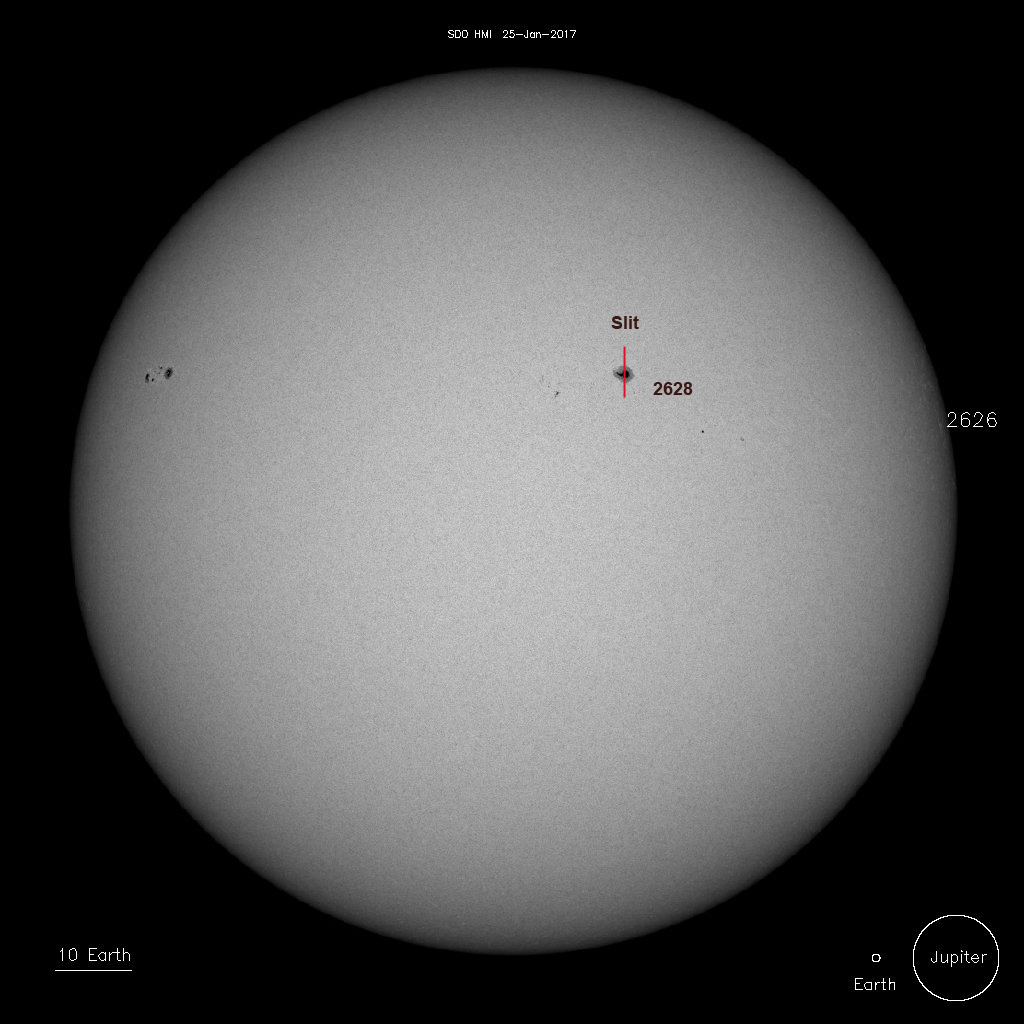
L’AR
2628 con la posizione della fenditura il 25 gennaio 2017 (fonte SDO-HMI).
AR 2628 with the position of the slit on january, 25, 2017 (source SDO-HMI).
La strumentazione usata
La strumentazione usata è
stata quella dei casi precedenti: Lo spettrografo Hires Solarscan
sviluppato, su progetto di chi scrive, dalla nota ditta Avalon di Aprilia (RM):Si
tratta di uno strumento di alta qualità tecnologica e meccanica completamente
automatizzato e remotizzabile, capace di risoluzioni spettrali anche
notevolmente superiori a R= 60000 in un peso di 15 Kg e una lunghezza di circa
110 cm, quindi perfettamente gestibile da una sola persona su montature
equatoriali di classe media come Losmandy G11 ed Avalon M1.La
camera era una IS DMK 41, con sensore Sony ICX 285 AL da 1280 x 1024 su
montatura Losmandy G 11.C’è da dire, a proposito della camera, che, pur avendo
recentemente acquistato una DMK 51 da 1600 x 1200, mi è sembrato che la 41 sia
più sensibile ed adatta per lavori al limite della strumentazione, come quello
in discorso.La vera novità rispetto alle precedenti osservazioni è stato l’uso,
come detto, di una fenditura fissa
da 5 micron.La macchia 2628 era infatti poco estesa, ed ho molti dubbi che sarei
riuscito a rivelarne l’effetto Zeeman senza l’uso della nuova fenditura.
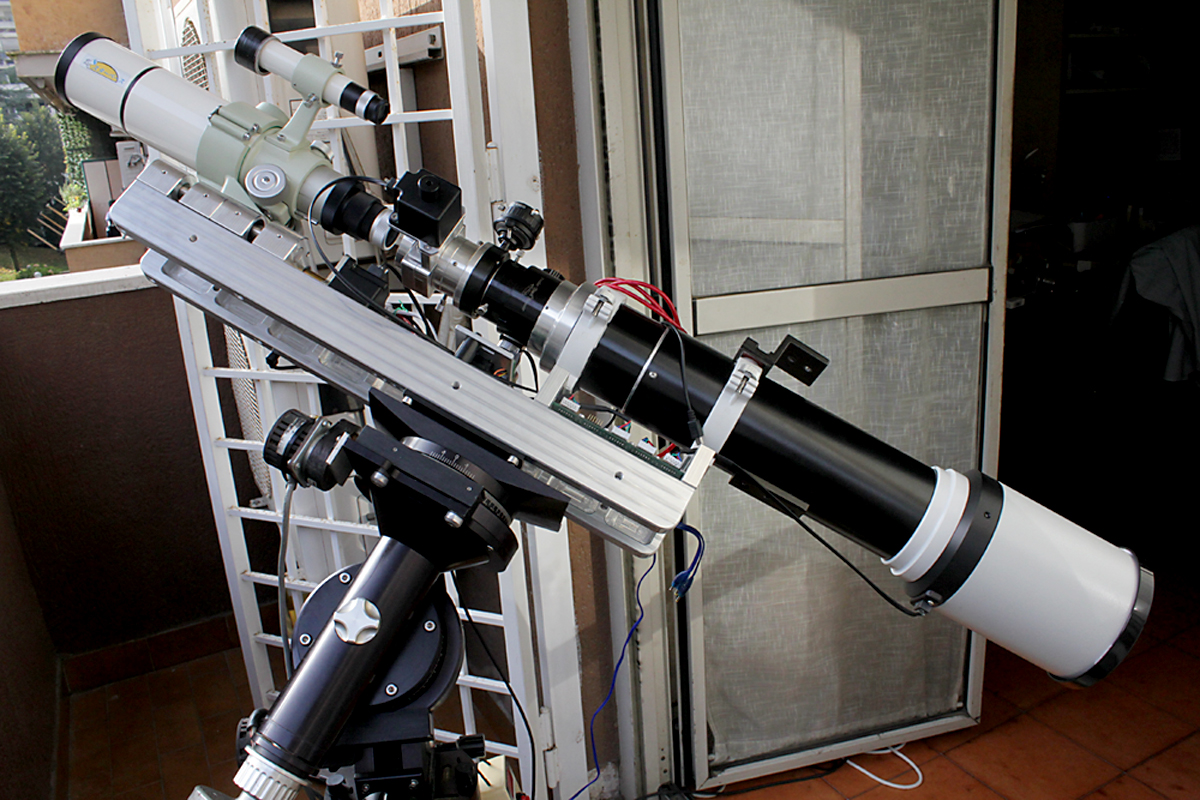
The equipment used
The equipment used was that of the previous cases: The Hires spectrograph
Solarscan developped, on my layout, by the known firm Avalon of Aprilia (Rome)
capable of remote operation, and a camera DMK 41, with Sony ICX 285 AL sensor
1280 x 1024 on Losmandy G 11 mount.I must say, about the camera, which, although
having recently purchased a DMK 51 1600 x 1200, it seemed that the 41 is more
sensitive and suitable for work at the limit of the equipment, like the one in
topic.The sunspot 2628 was in fact small and I have many doubts that I would be
able to reveal the Zeeman effect without the use of the new slit.
L’osservazione
The
observation
Lo spettro bidimensionale,
ottenuto dalla media di ca 300 frames del migliore tra 4 video era il seguente:
The bidimensional spectrum, obtained from the median of 300 frames of the better
of 4 videos was the following:
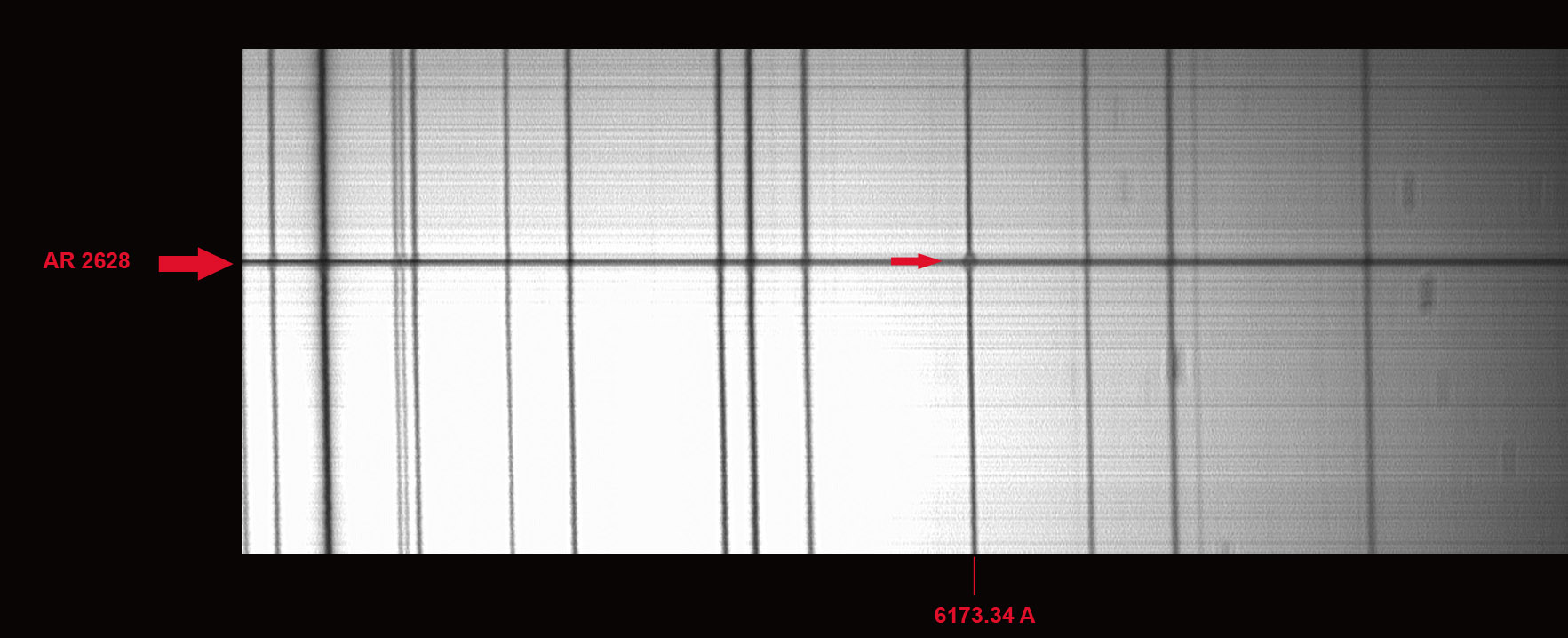
Ed il suo profilo
And its
profile
Lo spettro allargato lungo
l’asse x per la migliore identificazione dei centri riga splittati e, nel menu a
tendina blu,i risultati delle tre
misurazioni (ciascuna a sua volta media di tre).
The spectrum enlarged along x axis to enhance the center of the splitted lines
and, in the blue drop down menu, the result of three measures (each in turn
composed of three measure)
La procedura descritta,
per quanto laboriosa, sembra funzionare abbastanza bene e forniva i seguenti
risultati per i centri delle due righe , quella verso la parte blu dello spettro
e quella verso il rosso.
The described procedure, although laborious, seems to work quite well, and gave
the following results for the two center lines and their differences.
|
Toward
blue line |
Toward red line |
Difference |
Difference/2 (d Lambda) |
|
0.2596 |
0.4405 |
|
|
|
0.2596 |
0.4405 |
|
|
|
0.2491 |
0.4405 |
|
|
|
Median:
0.2561 |
Median:
0.4405 |
0.1844 |
0.0922 |
|
0.2490 |
0.4405 |
|
|
|
0.2490 |
0.4405 |
|
|
|
0.2490 |
0.4405 |
|
|
|
Median:
0.2490 |
Median:
0.4405 |
0.1915 |
0.0957 |
|
0.2490 |
0.4510 |
|
|
|
0.2490 |
0.4405 |
|
|
|
0.2490 |
0.4405 |
|
|
|
Median:
0.2490 |
Median:
0.4440 |
0.1950 |
0.0975 |
|
|
Median of differences |
0.1930 |
0.0965 |
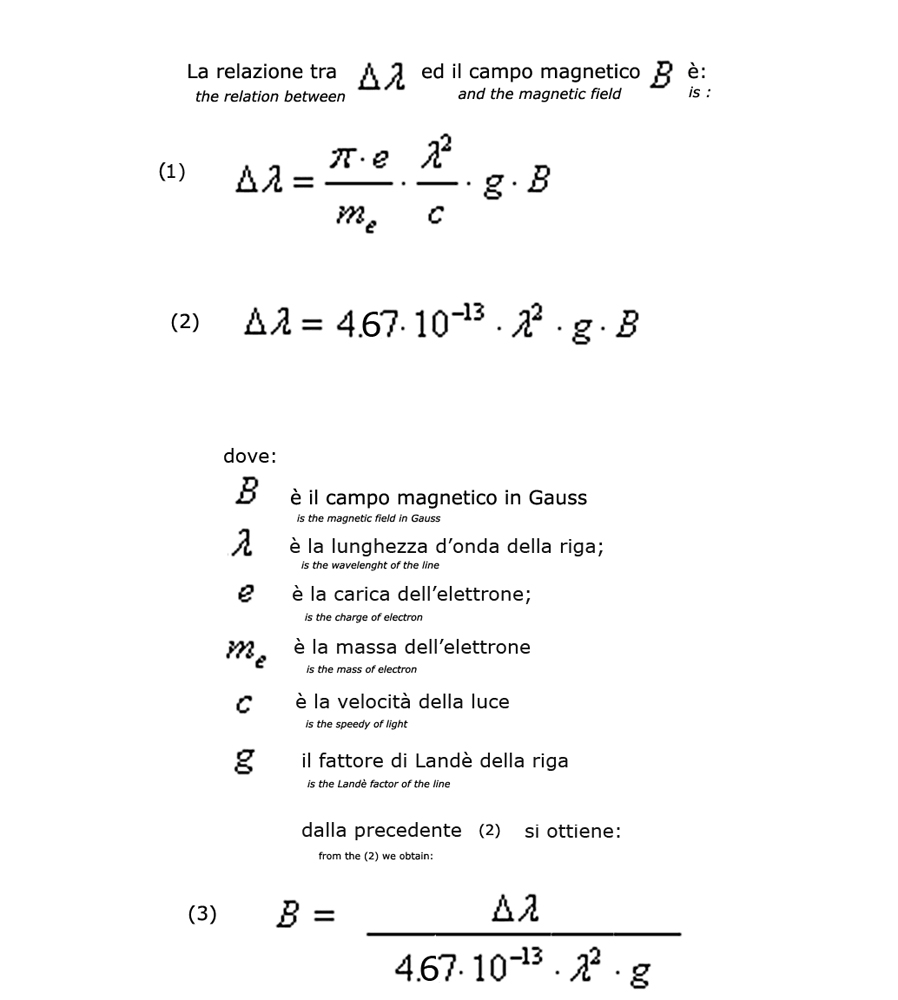
In definitiva è:

Per il calcolo dell’errore
statistico sul d lambda ottenuto si è usato il sistema della semi dispersione massima, già usato in
precedenza e suffiicientemente affidabile per tre misure; era quindi:
The calculation of statistical error on d lambda was done with the half maximum dispersion
method, quite reliable with only three measures, was then:
0.0975-0.0922 /2 = 0.00265
0.00265 x 10 ^13
=
59 Gauss
444886721
Quindi il valore trovato
era :
Then the final value was :
B=
2169+- 59 Gauss
AR 2638 - 26 febbraio 2017
Il target
Si trattava di una regione
attiva limitata e di una macchia piccola, di superficie appena superiore a
quella terrestre, la più piccola da me osservata sinora con Solarscan: questo
rendeva difficile l’osservazione dell’effetto
Zeeman sulla solita riga del ferro, ma comunque valeva provare.
The target
It was a limited active region and a small sunspot, just above the Earth's
surface, the smallest from me so far observed with Solarscan: this made it
difficult the observation of the Zeeman effect on the usual iron line, but still
worth try.
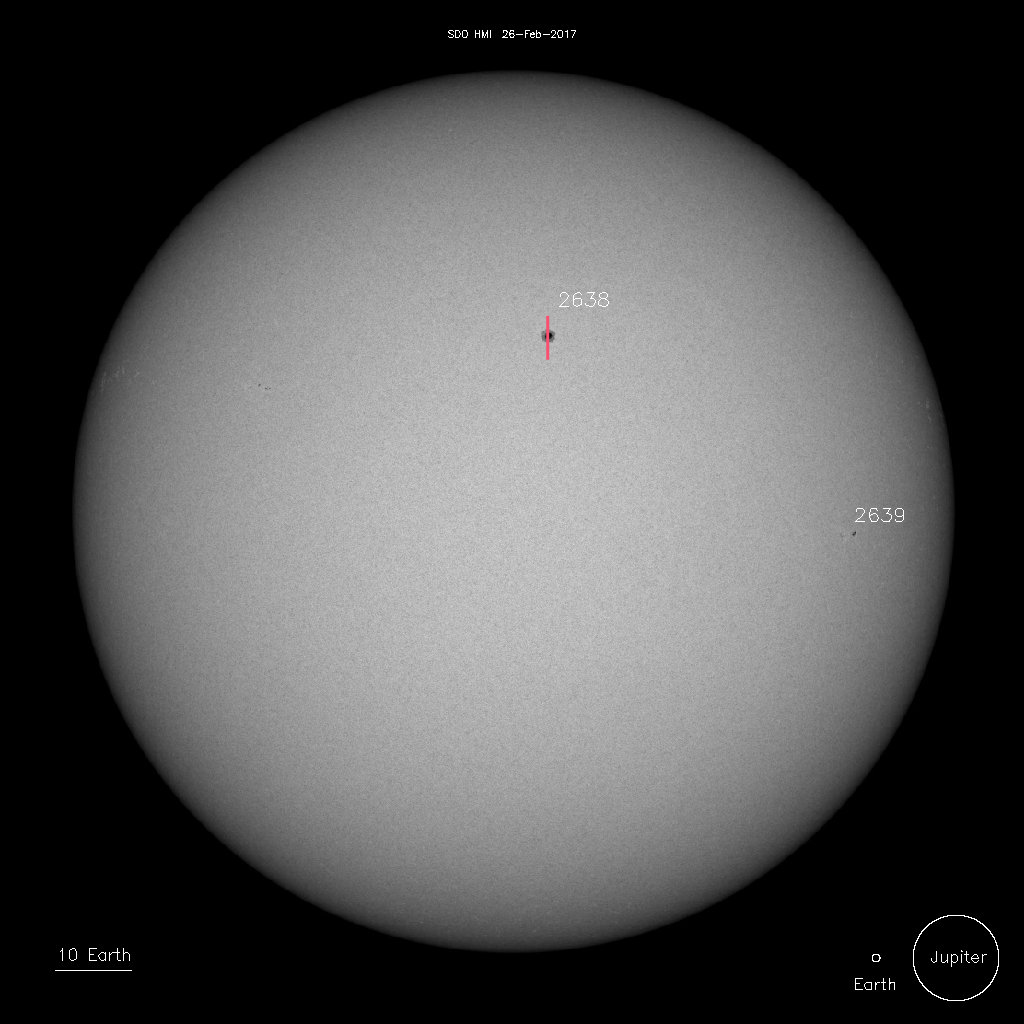
La macchia AR 2638 il 26
febbraio 2017- fonte SDO-HMI
Sunspot AR 2638 on february, 26, 2017 source SDO-HMI
L’osservazione
Lo spettro bidimensionale,
ottenuto dalla media di 300 frames su un video di 500.Tale video era stato
considerato il migliore di una serie di 4, presi in una giornata di seeing
cattivo.
The observation
The two-dimensional spectrum, obtained from the average of 300 video frames of a
video of 500.This had been considered the best of a series of 4, taken on a day
of bad seeing.
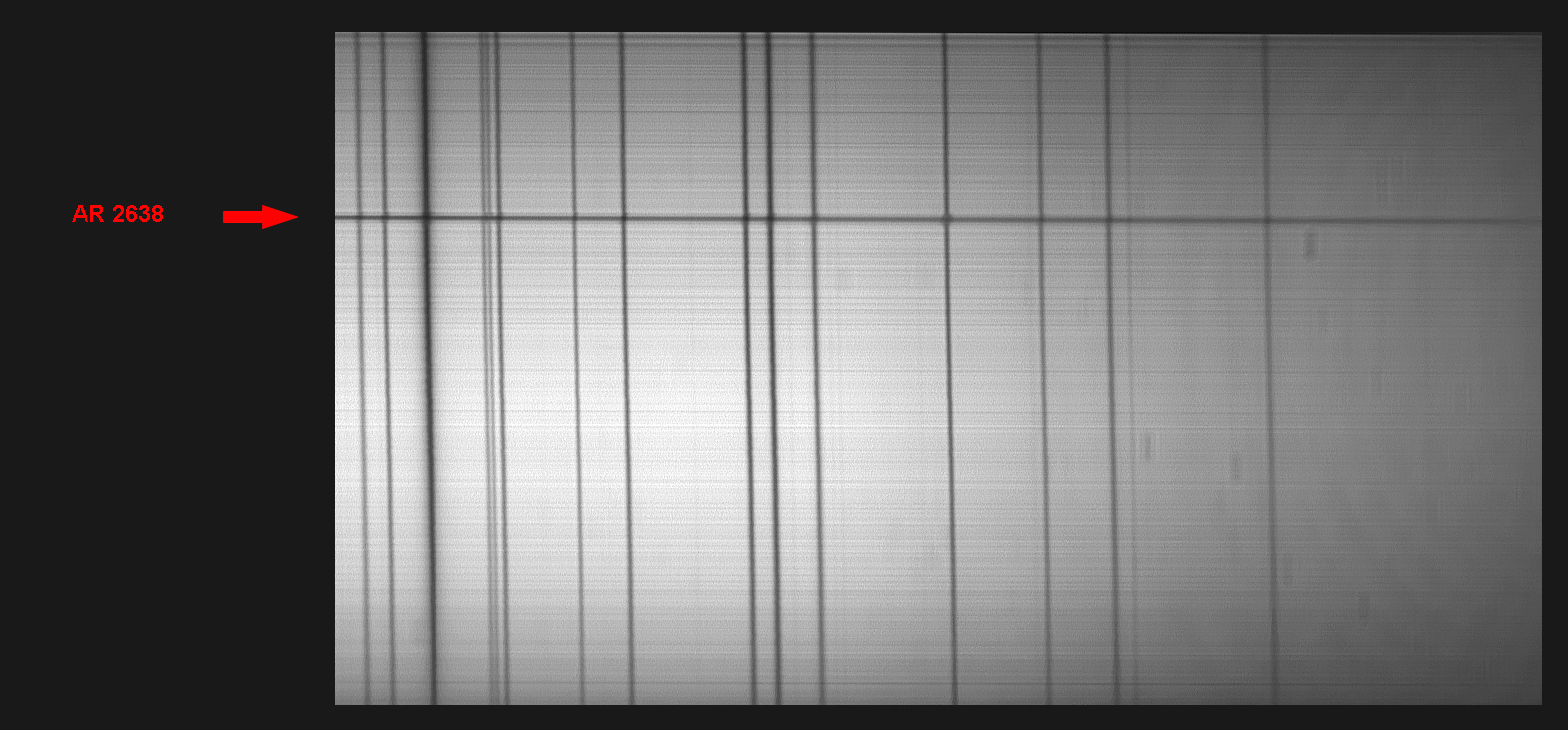
E, di seguito, il profilo
spettrale coi centri riga (3 misure per ciascun centro riga x 3 volte)
And, hereunder, the spectral profile with the line centers (three measures for
each line center for three times).
Le differenze delle medie
delle tre misure ed il d lambda sono state
rispettivamente pari a:
The difference of the median of the three measures and d lambda were:
0.1959
0.1959
0.2019
E la loro media pari a
And their
median of
0.1979 A
; d /lambda di 0.0989
Quindi, applicando la
formula precedente:
Then,
applying the previous formula:
0.0989 x 10 ^13
=
2223 Gauss
444886721
E l’errore:
And the
error:
0.1009-0.0979/2= 0.0015 A,
ovvero:
0.0015 x 10 ^13
=
34 Gauss
444886721
Quindi
B= 2223
+- 34 Gauss
Il target
Si trattava di una regione attiva formata da un gruppo bipolare con altre piccole macchie con penombra estesa ed ombra piuttosto ridotta, esteso in direzione est-ovest: la fenditura era posta sulla seconda macchia verso ovest.
The target
It was an active region formed by small sunspot, in a bipolar group, with a wide penumbra and small umbra, extended in est-west direction.The slit was put on the second sunspot.
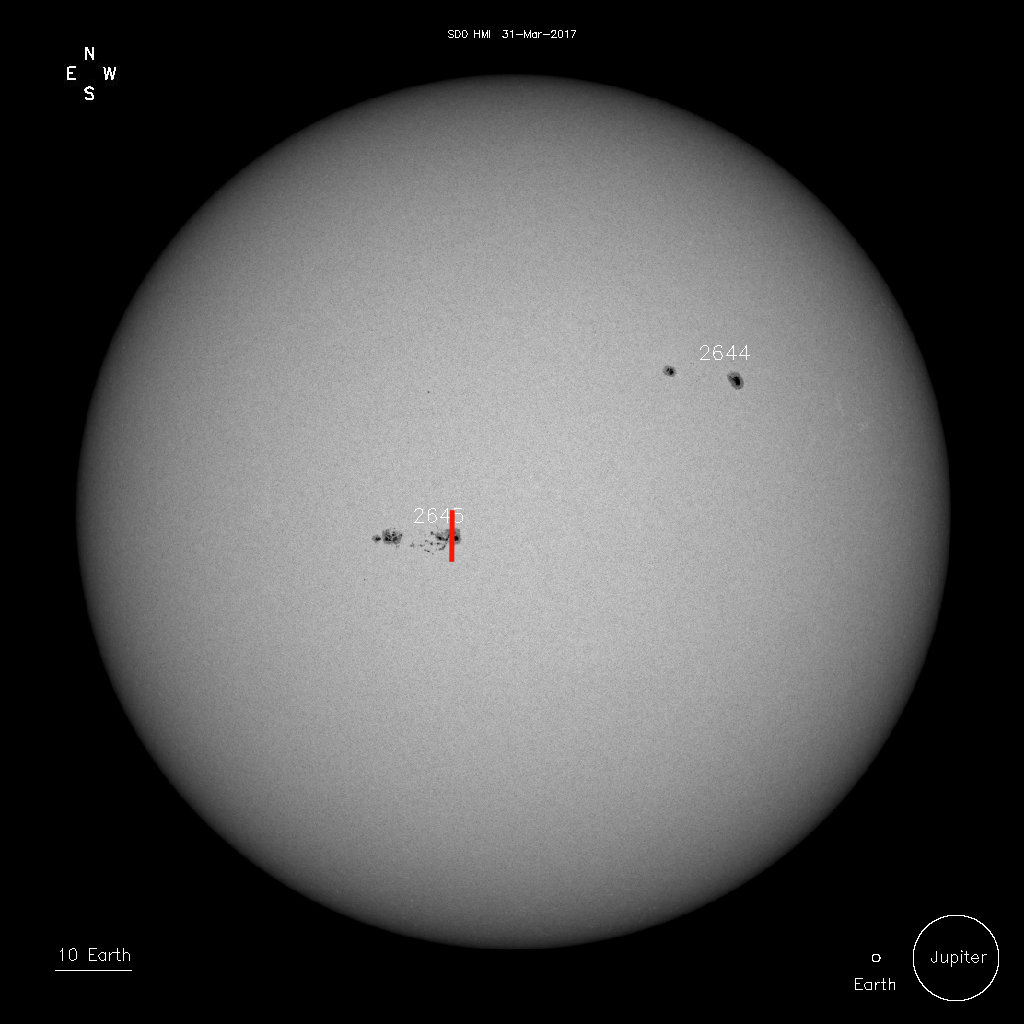
L’osservazione
Lo spettro bidimensionale, ottenuto dalla media di 600 frames su un video di 800.Tale video era stato considerato il migliore di una serie di 3.
The observation
The two-dimensional spectrum, obtained from the average of 600 video frames of a video of 800.This had been considered the best of a series of 3.
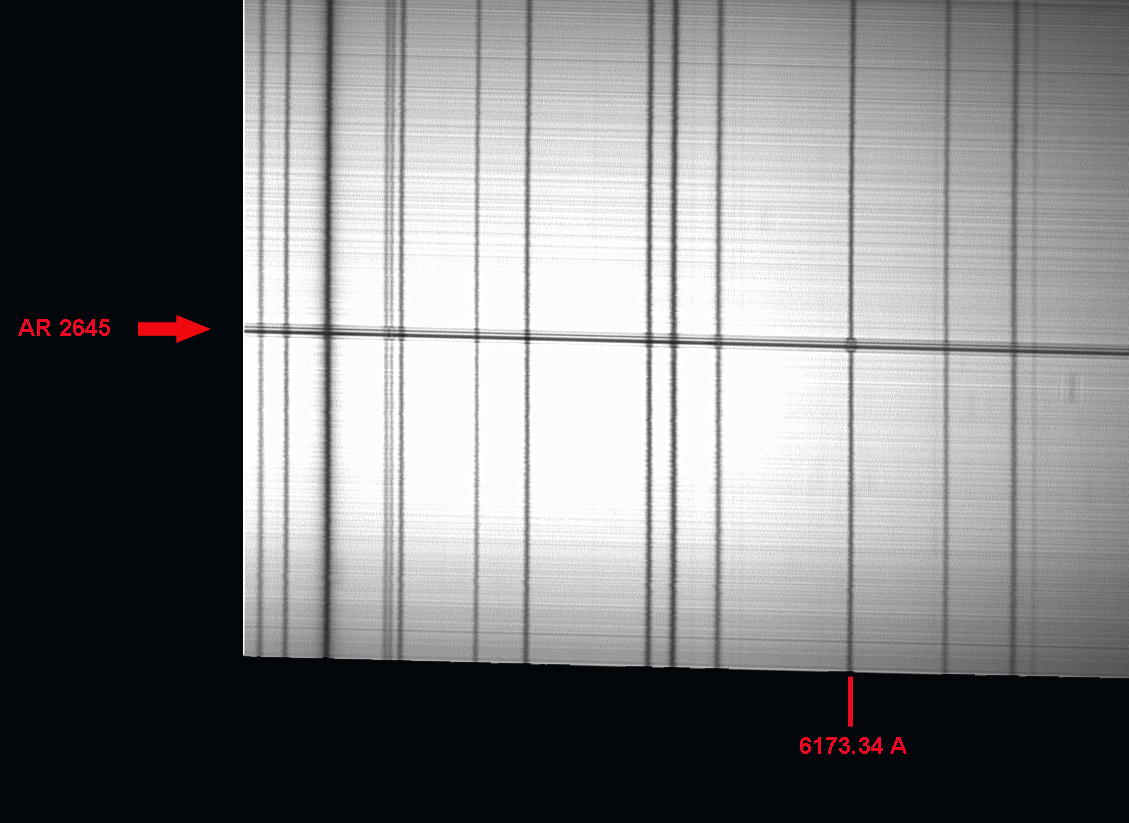
E, di seguito, il profilo
spettrale, calibrato come d'uso, coi centri riga (3 misure per ciascun centro riga x 3 volte)
And, hereunder, the spectral profile, calibrated as usual, with the line centers (three measures for
each line center for three times).
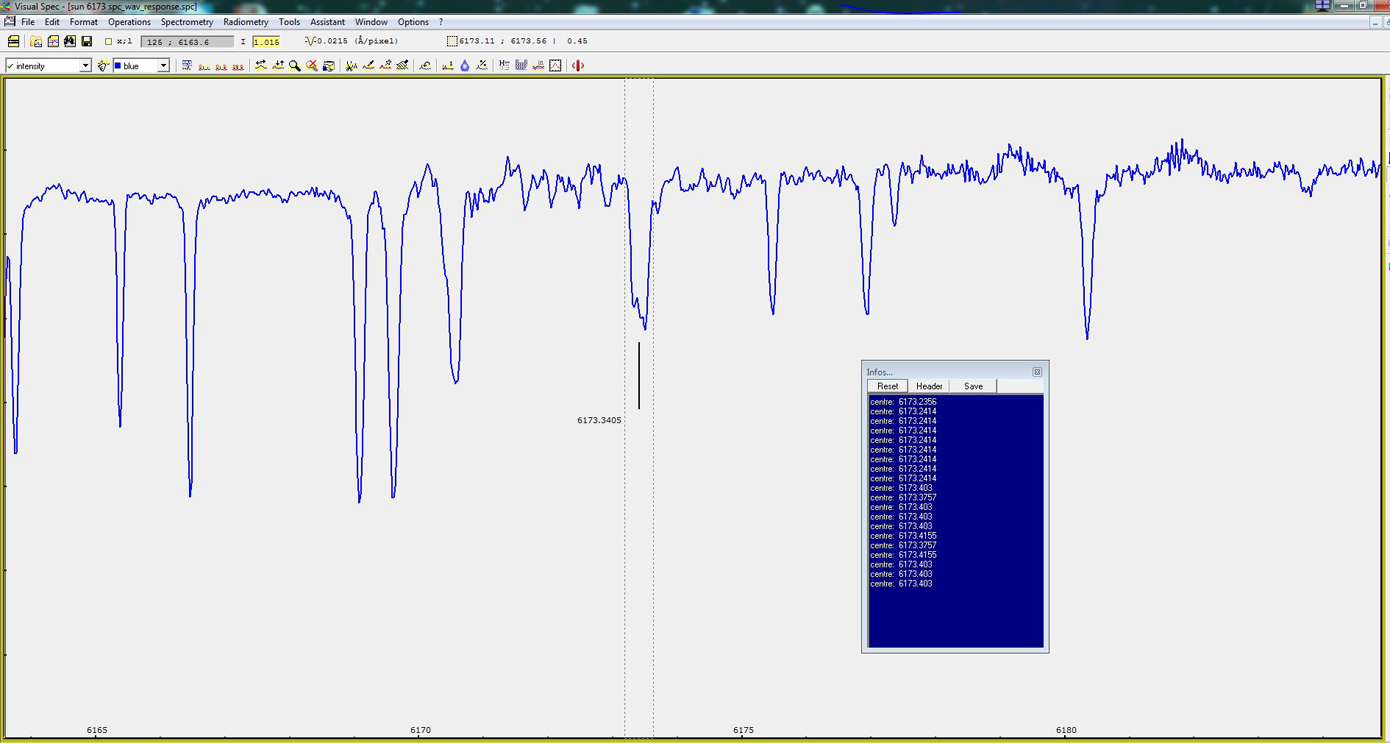
Le differenze delle medie
delle tre misure ed il relativo d
lambda sono state
rispettivamente pari a:
The difference of the median of the three measures and related d lambda were:
0.1
0.1657
0.1566
E la loro media pari a
And their
median of
0.1589 A ; d /lambda di 0.0794
Quindi, applicando la
formula precedente:
Then,
applying the previous formula:
0.0794 x 10 ^13
=
1785 Gauss
444886721
E l’errore:
And the
error:
0.0828-0.0772/2= 0.0028 A,
ovvero:
0.0028 x 10 ^13
=
63 Gauss
444886721
Quindi
B= 1785
+- 63 Gauss
Si trattava di una macchia molto piccola, di estensione ridotta (appena poco più del diametro terrestre, come si osserva dall'immagine sottostante (fonte SOHO-MDI).
It was a small sunspot, with a little more extension then the terrestrial diameter, how we can observe in the following image (source SOHO-MDI)
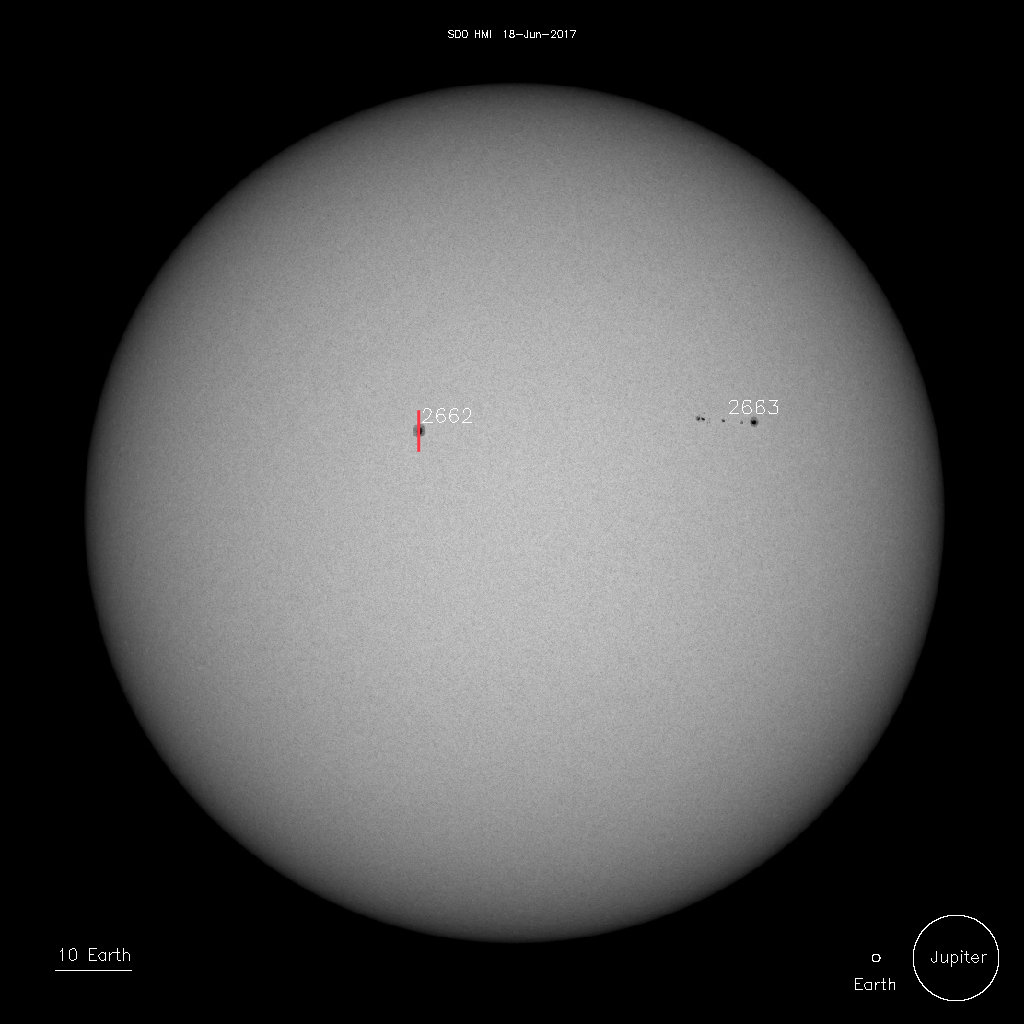
L’osservazione
Lo spettro bidimensionale, ottenuto dalla media di 500 frames su un video di 1000.Tale video era stato considerato il migliore di una serie di 3.Il seeing era sotto la media per vento.
The observation
The two-dimensional spectrum, obtained from the average of 500 video frames of a video of 1000.This had been considered the best of a series of 3. The seeing was under the median for wind.
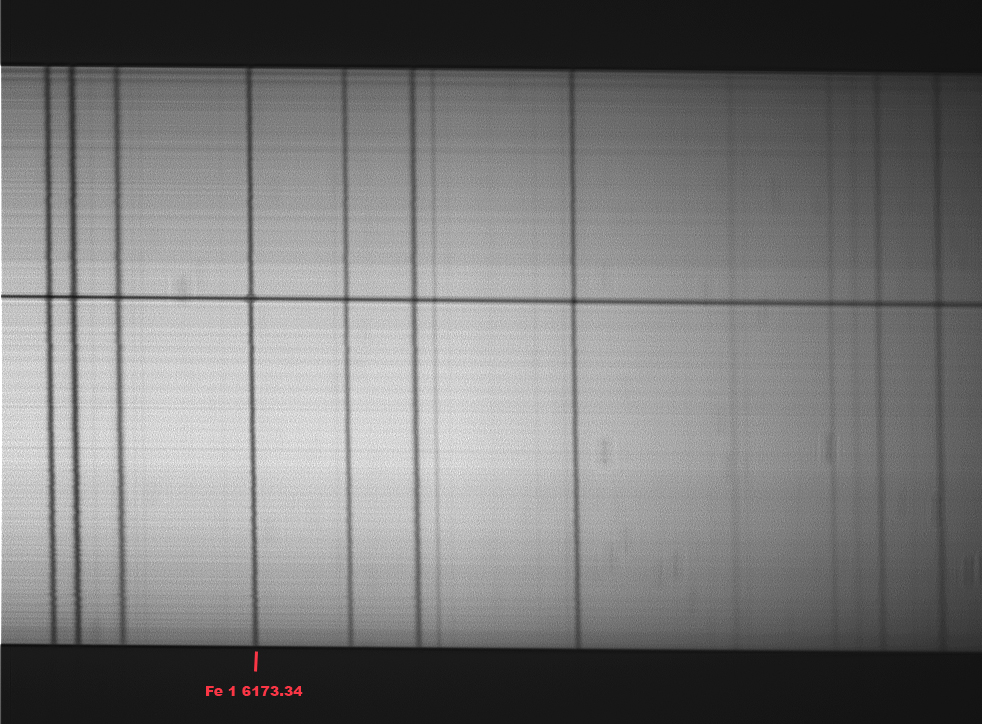
E, di seguito, il profilo
spettrale, calibrato come d'uso, coi centri riga (3 misure per ciascun centro riga x 3 volte)
And, hereunder, the spectral profile, calibrated as usual, with the line centers (three measures for
each line center for three times).
Le differenze delle medie
delle tre misure ed il relativo d
lambda sono state
rispettivamente pari a:
The difference of the median of the three measures and related d lambda were:
0.196 0.0980
E la loro media pari a
And their
median of
0.194 A ; d /lambda di 0.097
Quindi, applicando la
formula precedente:
Then,
applying the previous formula:
0.097 x 10 ^13
= 2180 Gauss
444886721
E l’errore:
And the
error:
0.0980-0.0965/2= 0.00075 A,
ovvero:
0.00075 x 10 ^13
=
17 Gauss
444886721
Quindi B= 2180 +- 17 Gauss
AR
2665 - 10 luglio 2017
Il 7 luglio è apparsa sul disco solare quella che potrebbe
essere il gruppo di macchie più esteso dell'anno in corso ,vi
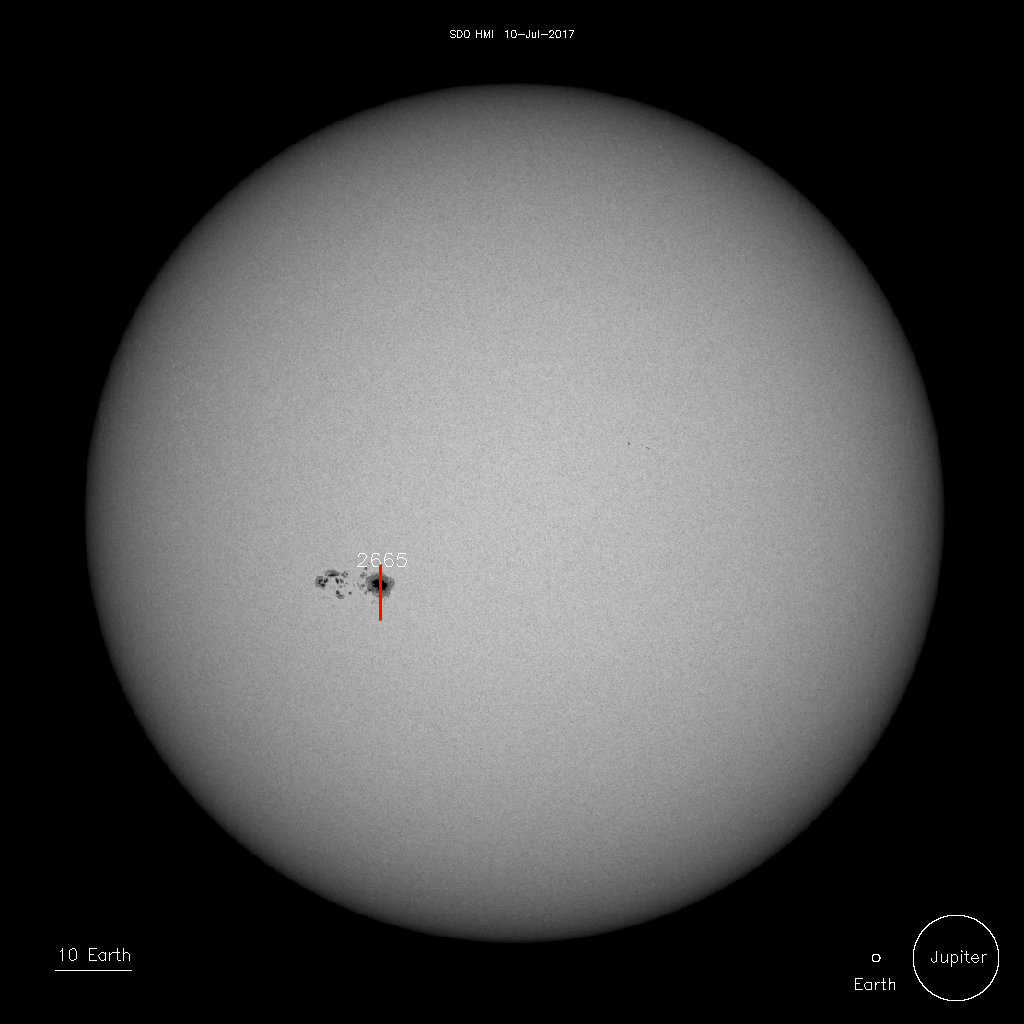
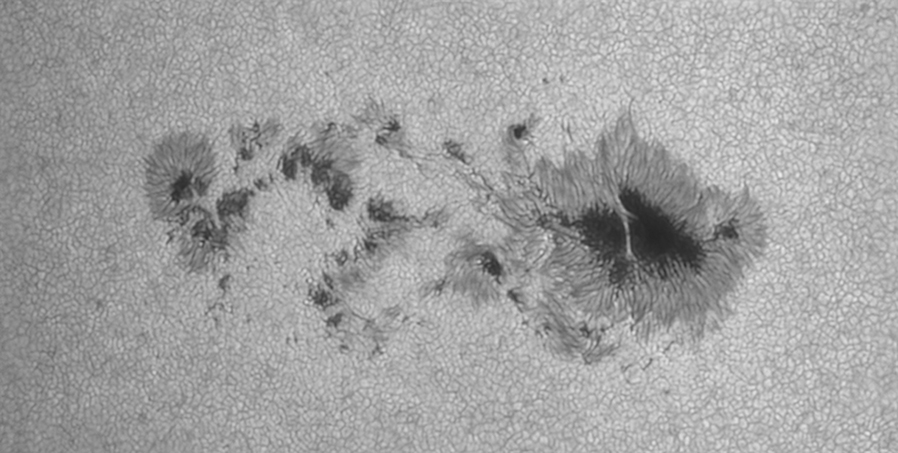
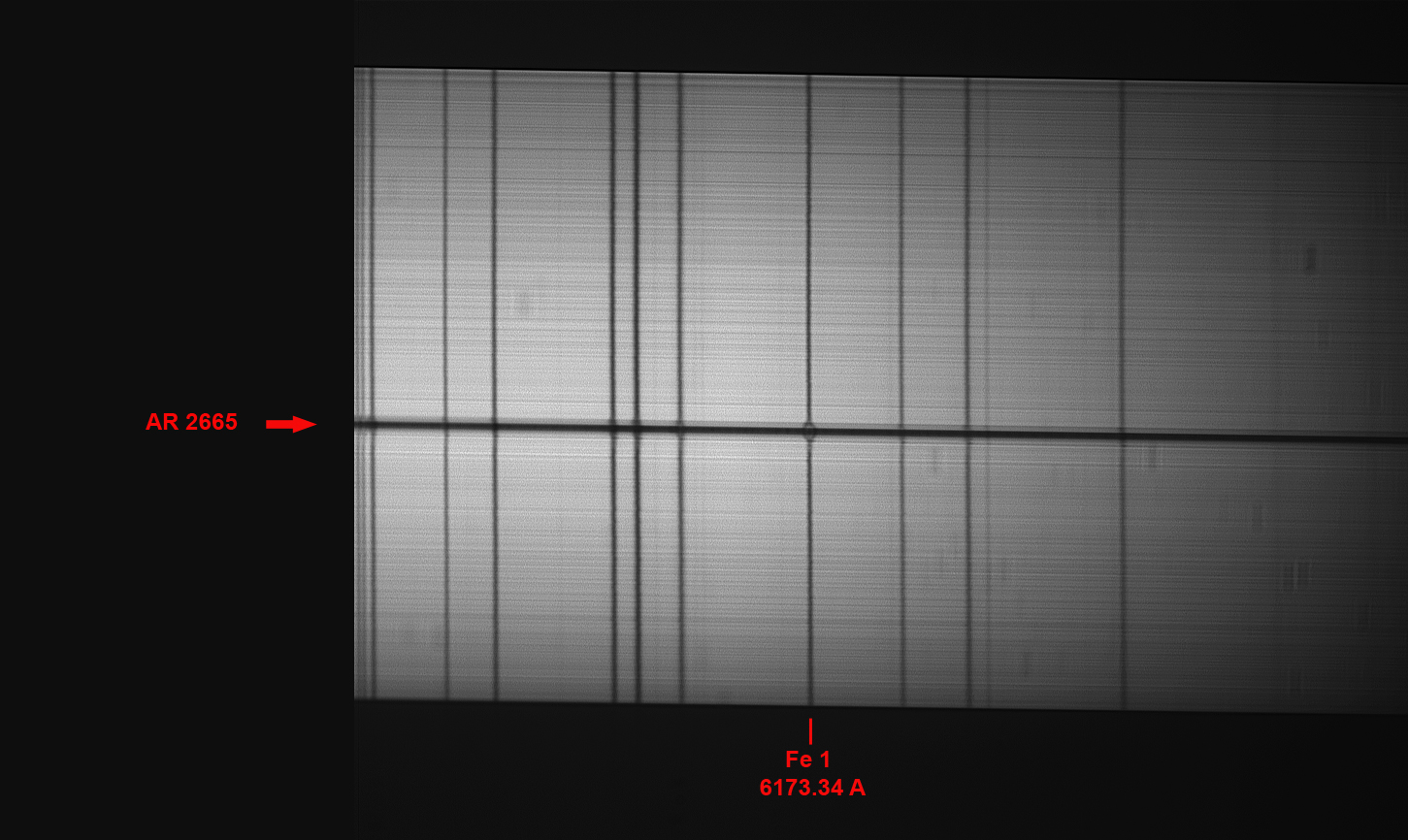
Nell'immagine che segue si osserva il profilo spettrale con le tre cuspidi dello splitting, compresa quella centrale, per la prima volta da me osservata con tale chiarezza.
In the image that follows, the splitted Zeeman line
Le differenze delle medie
delle tre misure delle due cuspidi
a lato del centro riga ed il relativo d
lambda sono state
rispettivamente pari a:
The difference of the median of the three measures and related d lambda were:
E la loro media pari a
And their
median of
0.240 A ; d /lambda 0.120 A
Quindi, applicando la
formula precedente:
Then,
applying the previous formula:
0.120 x 10 ^13
= 2697 Gauss
444886721
E l’errore:
And the
error:
0.1206-0.1198/2= 0.0004 A,
ovvero:
0.0004 x 10 ^13
=
9 Gauss
Quindi B= 2697 +- 9 Gauss
1-
1- The value in Gauss of sunspot 2665
magnetic field is the highest
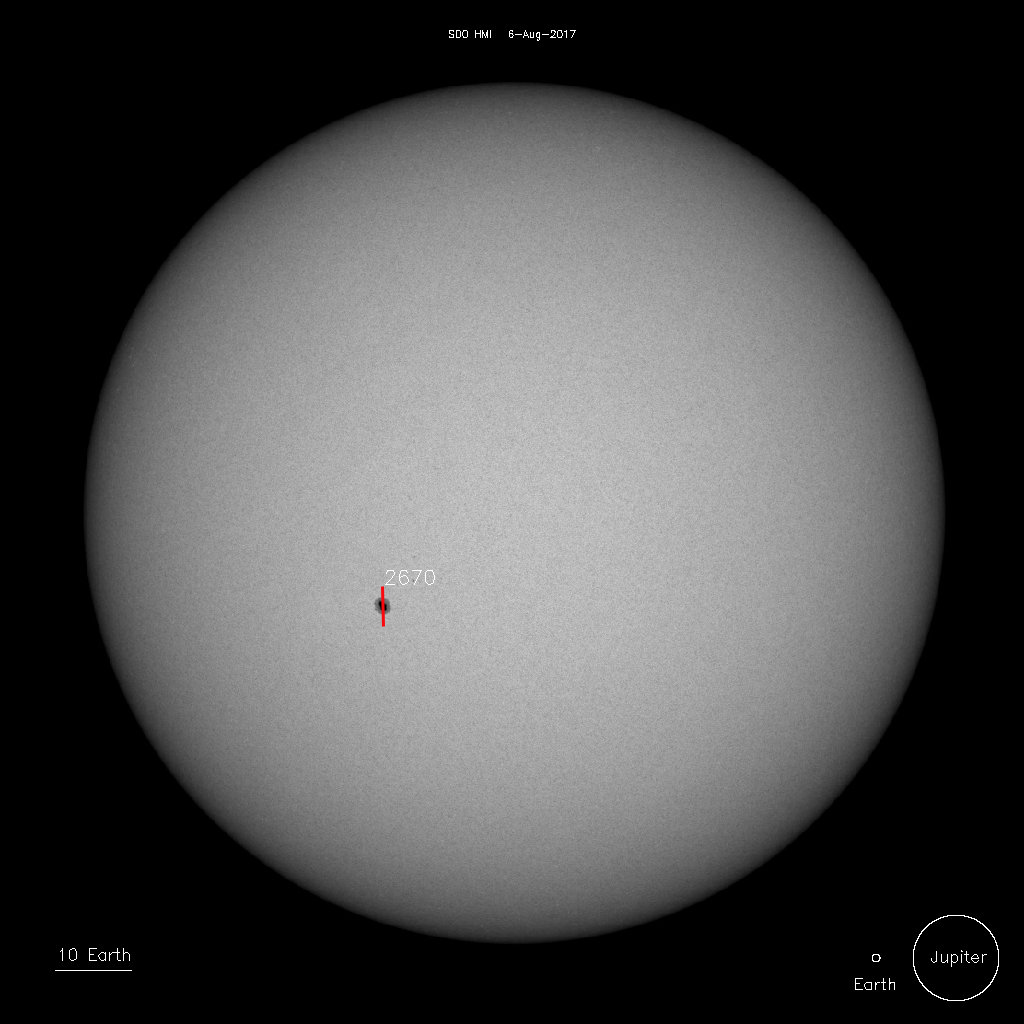
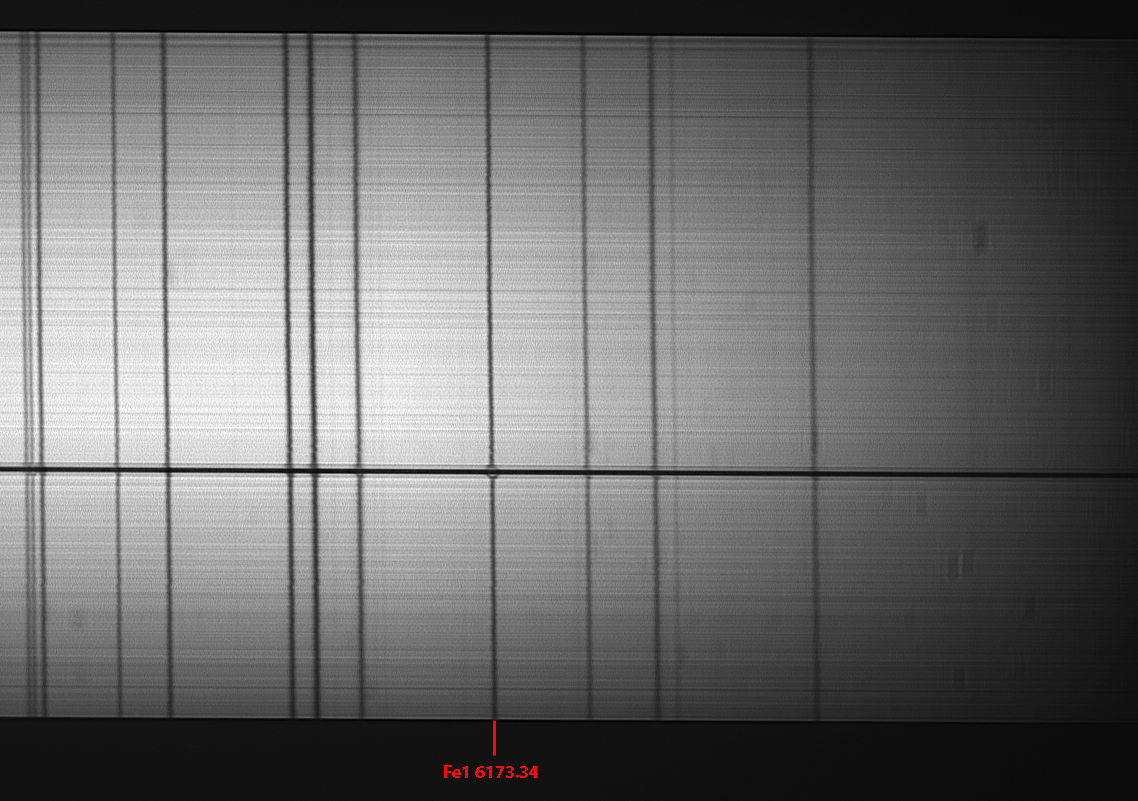
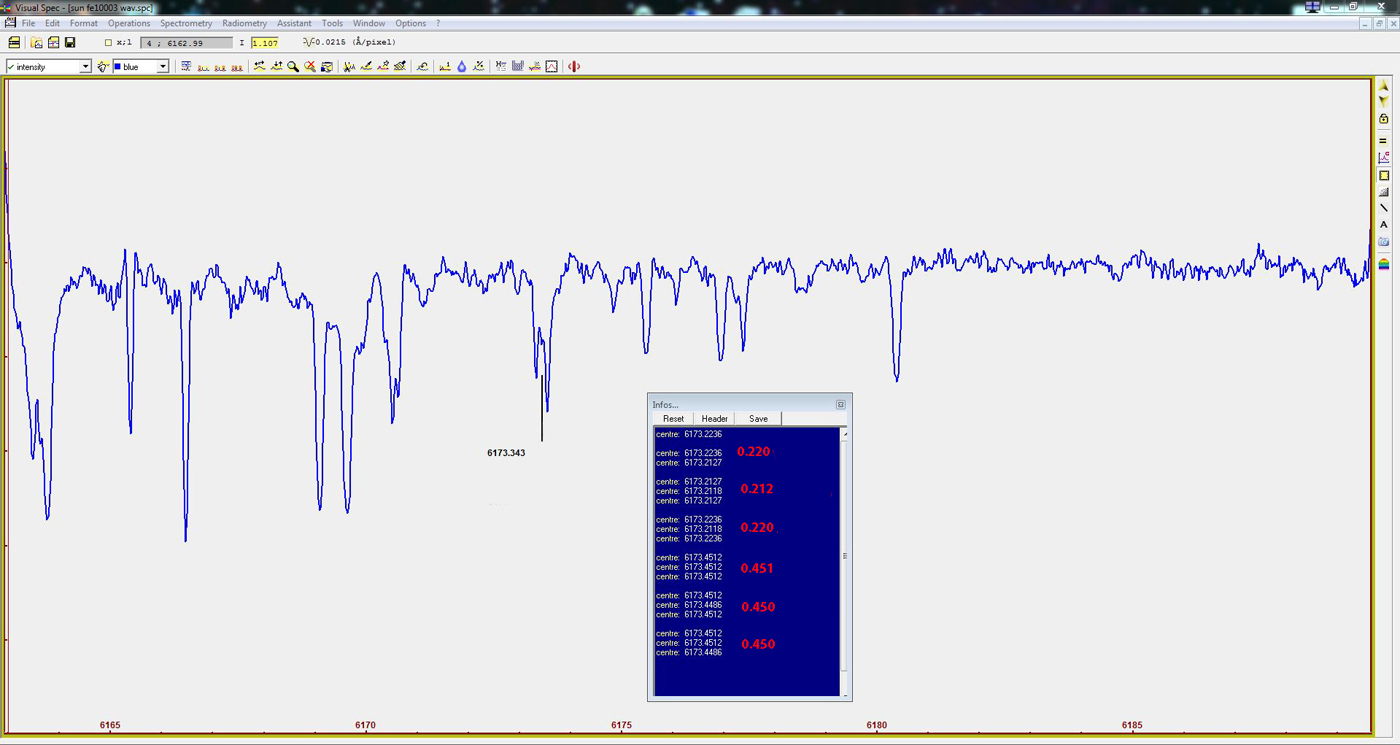
Le differenze delle medie
delle tre misure delle due cuspidi
a lato del centro riga ed il relativo d
lambda sono state
rispettivamente pari a:
The difference of the median of the three measures and related d lambda were:
E la loro media pari a
And their
median of
0.233 A ; d /lambda 0.116 A
Quindi, applicando la
formula precedente:
Then,
applying the previous formula:
0.116 x 10 ^13
= 2607 Gauss
444886721
E l’errore:
And the
error:
0.1190-0.1150/2= 0.002 A,
ovvero:
0.002 x 10 ^13
=
45 Gauss
AR
2671 - 22 agosto 2017
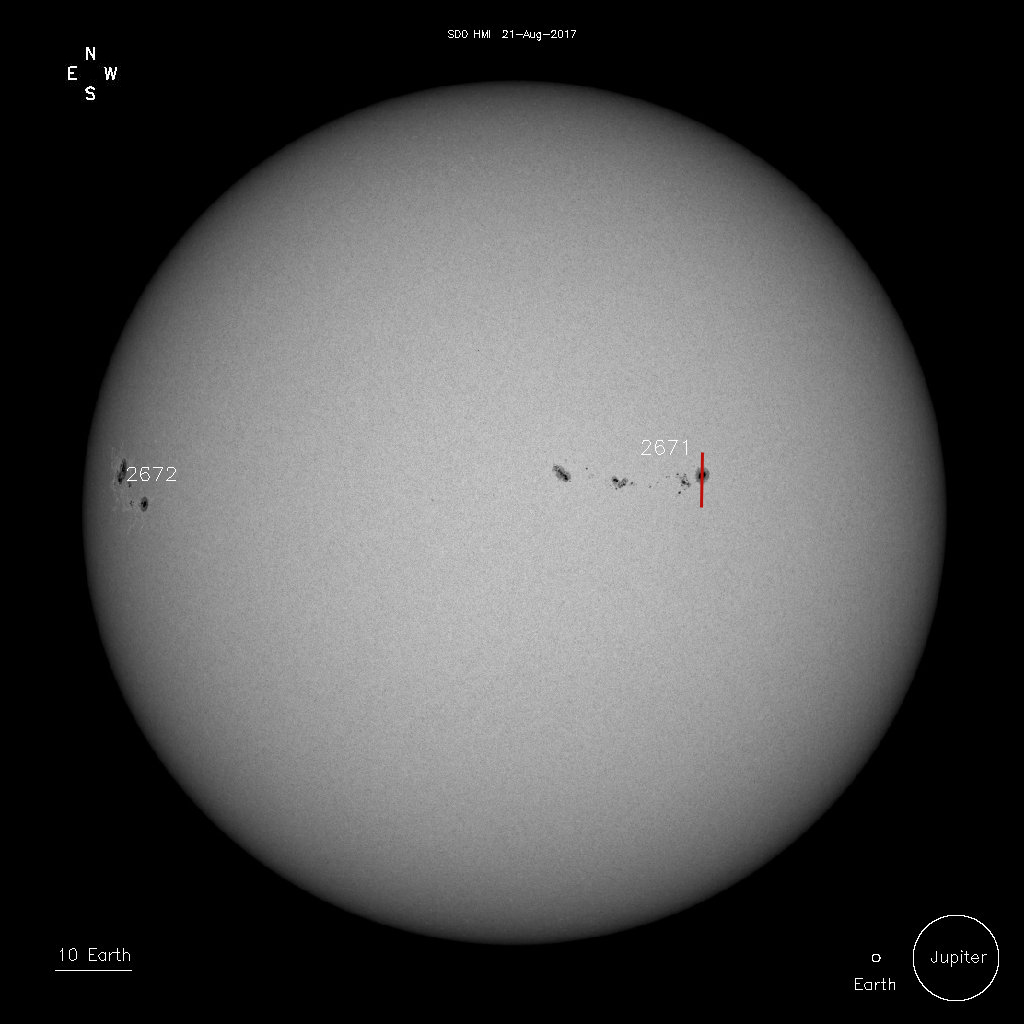
Il profilo spettrale
The spectral profile
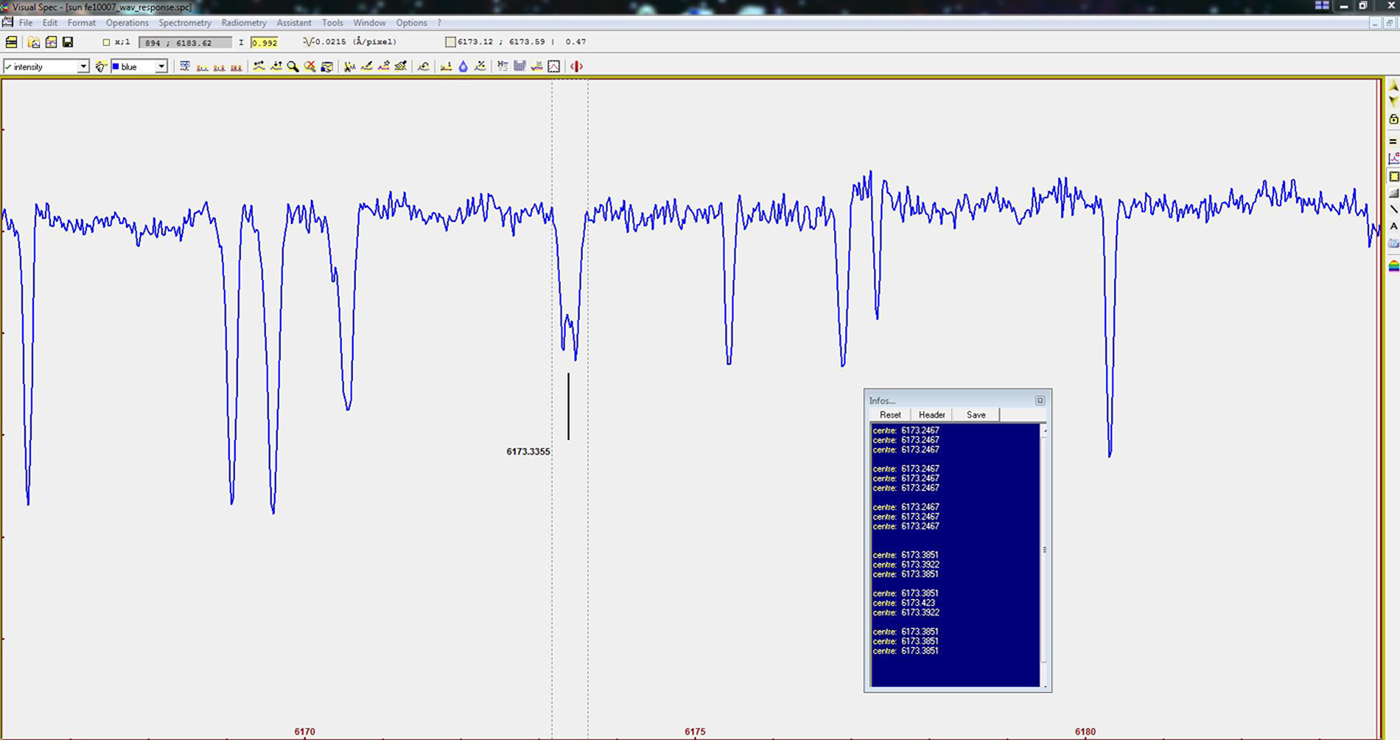
Le differenze delle medie
delle tre misure delle due cuspidi
a lato del centro riga ed il relativo d
lambda sono state
rispettivamente pari a:
The difference of the median of the three measures and related d lambda were:
E la loro media pari a
And their
median of
0.1442 A ; d /lambda 0.0721 A
Quindi, applicando la
formula precedente:
Then,
applying the previous formula:
0.0721 x 10 ^13
= 1621 Gauss
444886721
E l’errore:
And the
error:
0.0767-0.0692/2= 0.0075 A,
ovvero:
0.0075 x 10 ^13
=
169 Gauss
Il valore alto dell’errore è attribuibile alla scarsa definizione della riga splittata verso il rosso ed alla conseguente difficoltà del software di ottenere il centro riga.
The high value of the error is probably due to the low definition of the splitted line toward the red and to the consequent difficulty of the software to get the center of the line
.jpg)
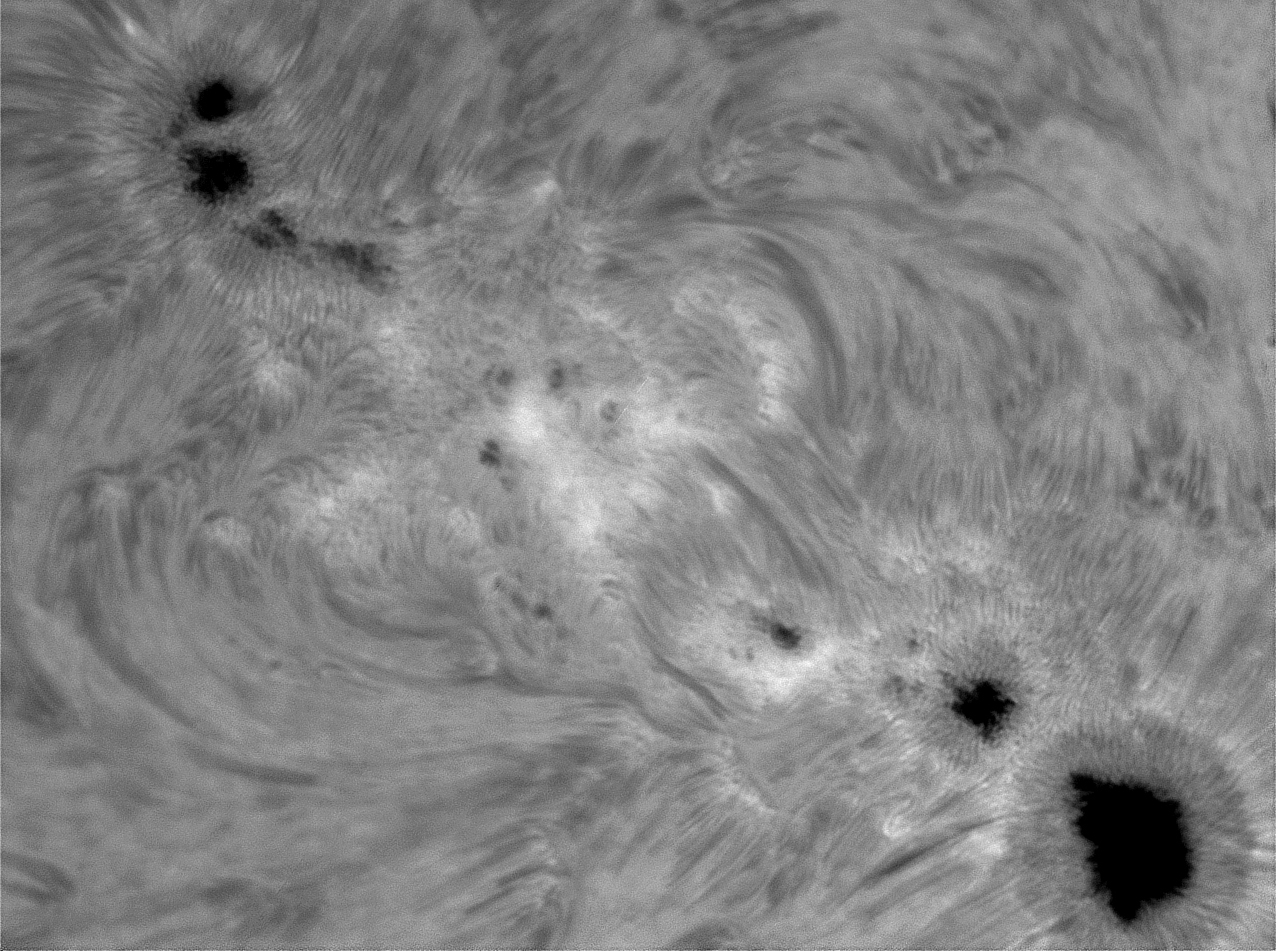
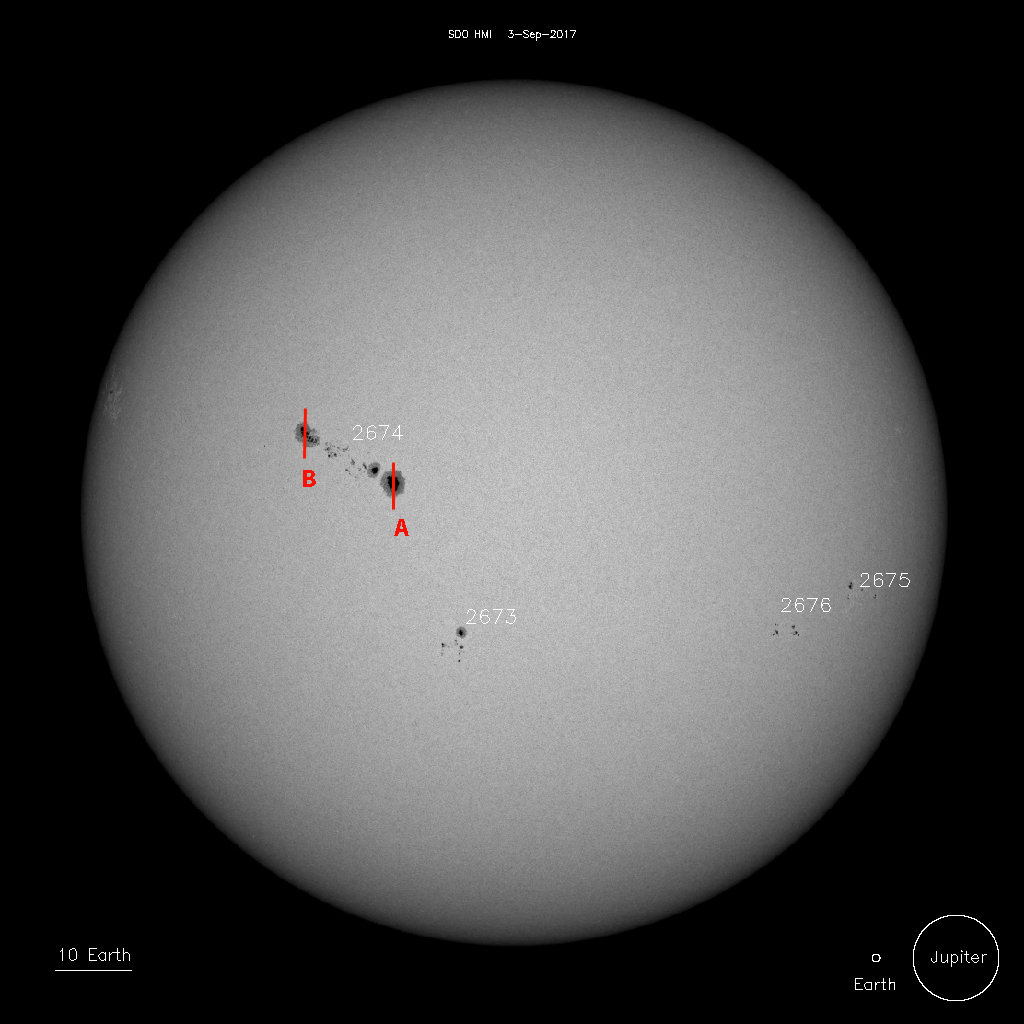
1- Componente A del gruppo
component A of the group
Lo spettro bidimensionale e l'area di binning:
Bidimensional spectrum and binning area
Il profilo spettrale: si notano tutte e tre le cuspidi delle righe Zeeman risultanti dalla scomposizione della Fe1 a 6173
The spectral profile: we clearly note all the three lines of the Zeeman splitting of the 6173 A Fe1 line.
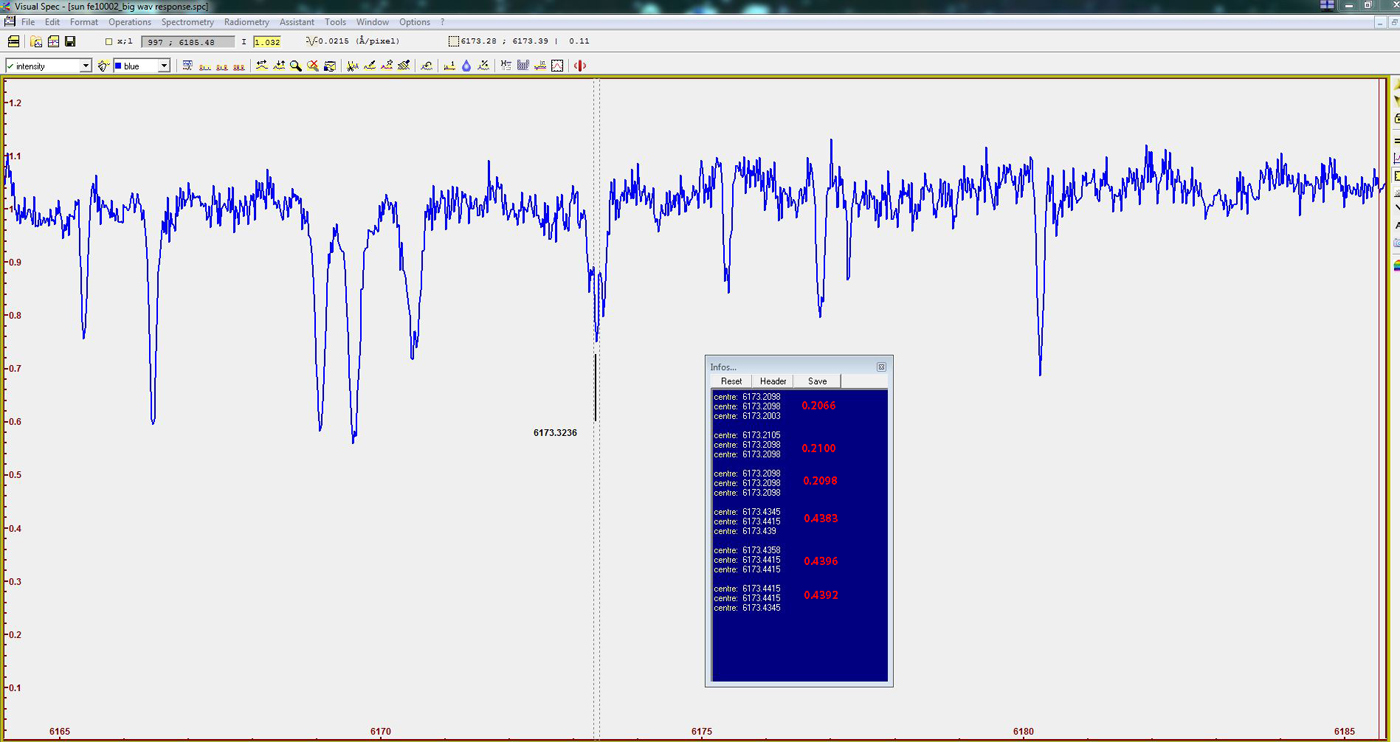
Le differenze delle medie
delle tre misure delle due cuspidi
a lato del centro riga ed il relativo d
lambda sono state
rispettivamente pari a:
The difference of the median of the three measures and related d lambda were:
E la loro media pari a
And their
median of
0.2302 A ; d /lambda 0.1151 A
Quindi, applicando la
formula precedente:
Then,
applying the previous formula:
0.1151 x 10 ^13
= 2588 Gauss
444886721
E l’errore:
And the
error:
0.1158-0.1147/2= 0.00055 A,
ovvero:
0.00055 x 10 ^13
=
12 Gauss
Si può notare l'errore piuttosto esiguo,probabilmente merito del seeing notevole del giorno
We can note the low error, probably due to the excellent seeing of the day
Quindi
B= 2588+-
12 Gauss
2- Componente B del gruppo
Component B of the group
Lo spettro bidimensionale della componente B era molto meno intenso nello splitting Zeeman della riga, come si osserva nell'immagine:difficile dire a cosa questo sia attribuibile, ma una delle cause potrebbe essere quella che l'ombra della componente B, come si osserva dalle foto, era divisa in due parti, così sulla fenditura cadeva solo una delle due metà.
The bidimensional spectrum showed a more less intense Zeeman splitting of the Iron line: difficult to say the cause of this; may be the structure of component B, whose umbra, as you can see from the photos, was divided in two parts, so the slit covered only one of the two.
La conseguenza era che VSpec non riusciva a separare nettamente le righe Zeeman,come si osserva nell'immagine del profilo, nè tantomeno ad indicarne i centri.Sono tuttavia riuscito ad ottenere i soli centri riga della parte centrale e di quella rivolta verso il rosso, misurandone il valore.
The consequence was that VSpec wasn't able to split clearly the Zeeman lines, but only (and hardly) the two of the center and of that toward the red, measuring their value.
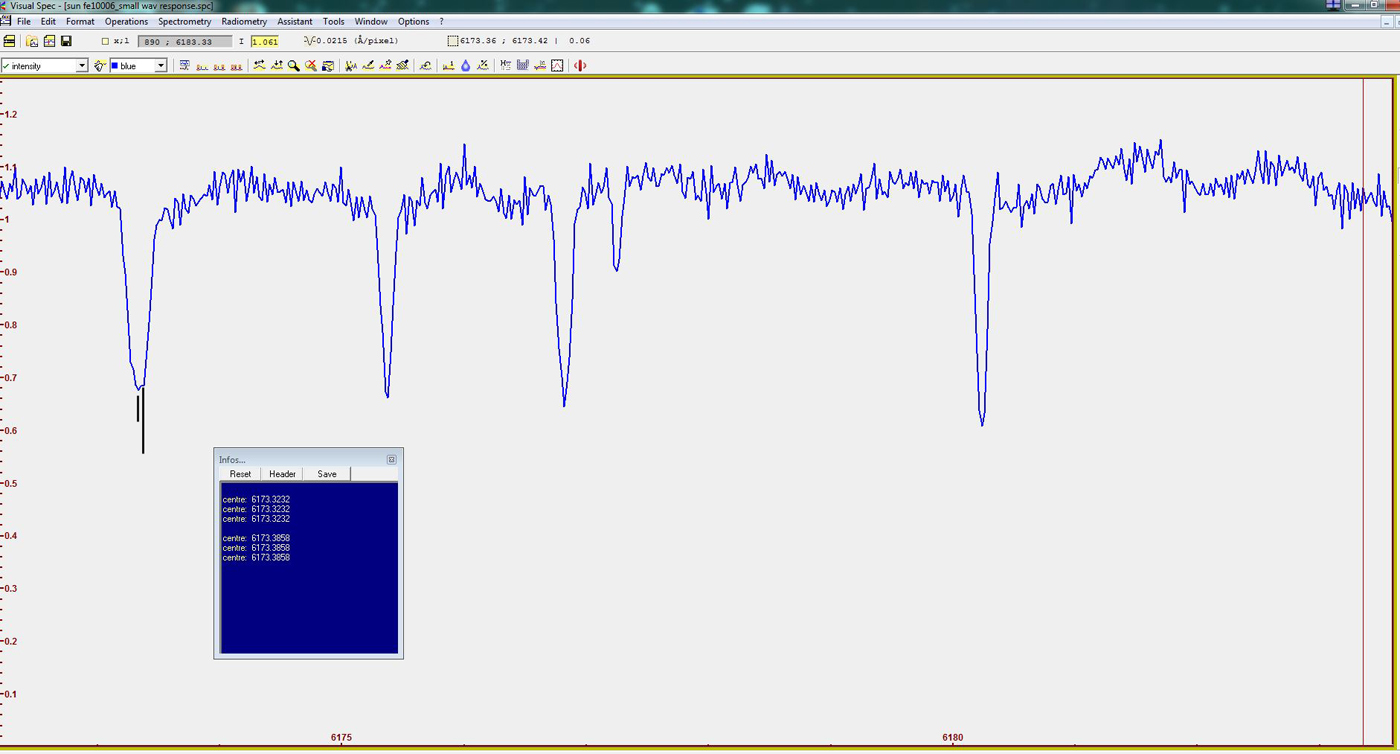
0.0626 x 10 ^13
=
1407 Gauss
Not being
possible to evaluate the error
B= 1407 Gauss
AR
2673 - 6 settembre 2017
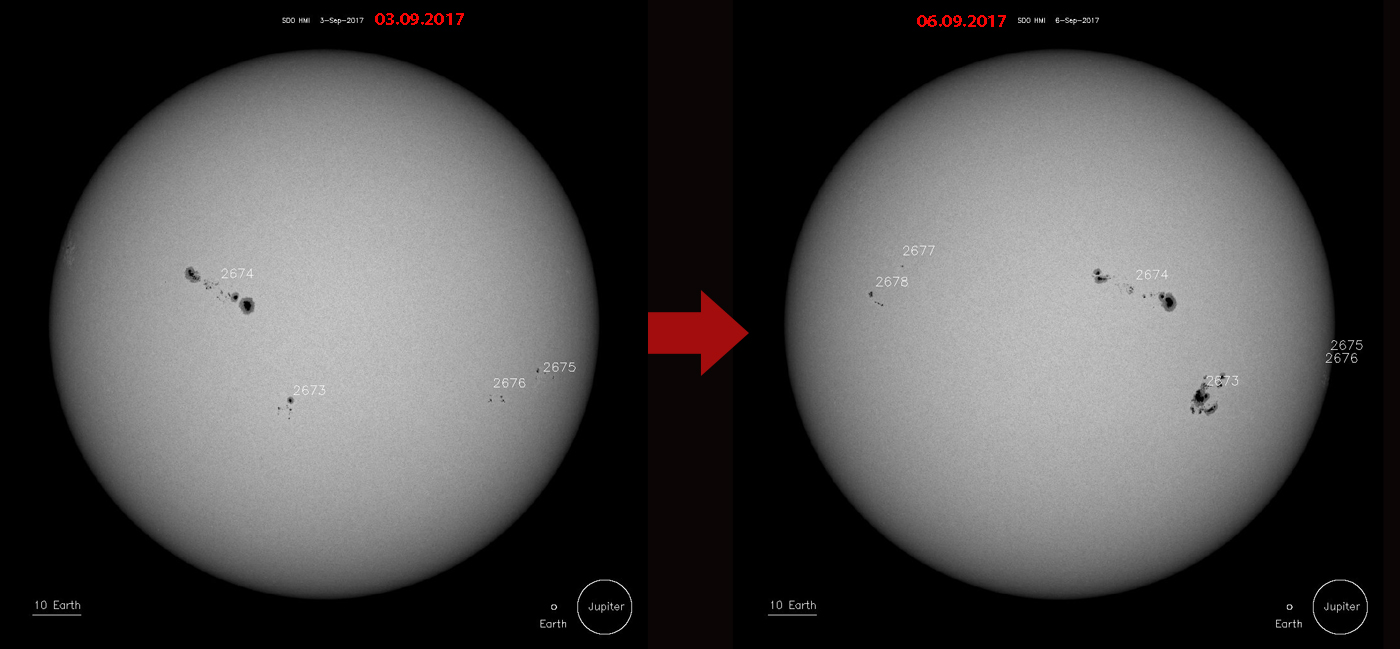
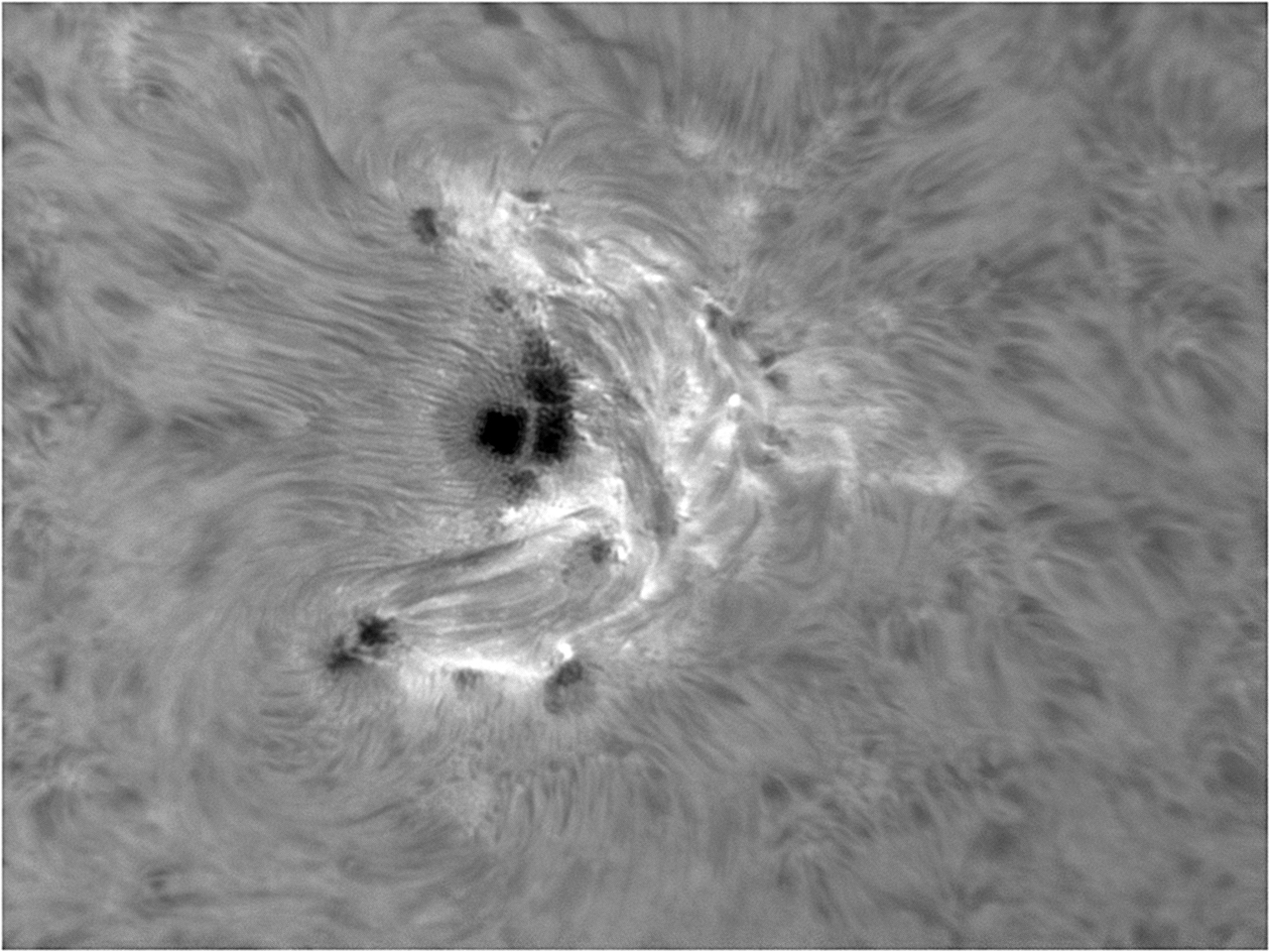
Il 6 settembre, data della ripresa spettroscopica della macchia, questa era prossima al culmine della sua forza, e presentava il seguente spettro bidimensionale, con indicata l'area di binning sulla quale è stato ricavato il profilo:
On september, 6, date of spectroscopic shot of the sunspot, it showed the following two-dimensional spectrum, on which is indicated the binning area
Come si può osservare sopra e sotto la macchia centrale si notano gli effetti delle altre due componenti del gruppo.E' bene precisare che la misura del campo magnetico ha riguardato la sola ombra della macchia principale del gruppo, sulla quale era puntata la fenditura, come si osserva nell'immagine del disco solare che segue .E' stata, inoltre, usata per l'acquisizione dei filmati (sei in tutto, dei quali si è scelto il migliore con lo stacking di 400 frames) una camera IS DMK 51 di risoluzione maggiore, 1600 x 1200 pixel contro i 1280x 960 della DMK 41 normalmente usata, ma di sensibilità lievemente inferiore.In conseguenza la dispersione spettrale è stata di 0.0200 A/pix anzichè gli usuali 0.0215.
As you can see above and below the central spot, you can notice the effects of the other two components of the group. It is worth pointing out that the magnetic field measurement was only the umbra of the group's main spot on which the slit was pointed, as it is observed in the image of the following solar disc. It was also used to capture the videos (six of them were the best one with 400 frames stacking) an IS DMK 51 camera of resolution 1600 x 1200 pixels larger than the DMK 41 1280x 960 normally used but with slightly lower sensitivity. As a result spectral dispersion was 0.0200 A / pix instead of the usual 0.0215.
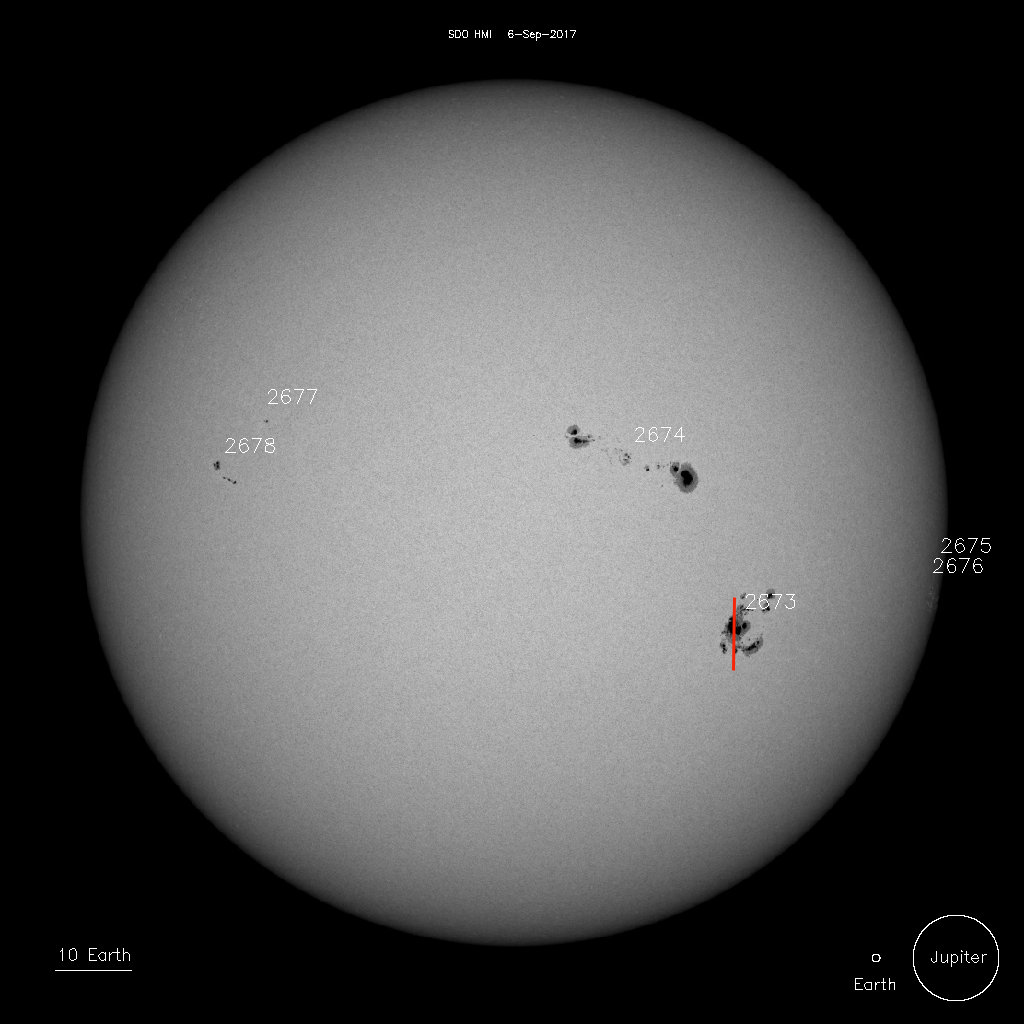
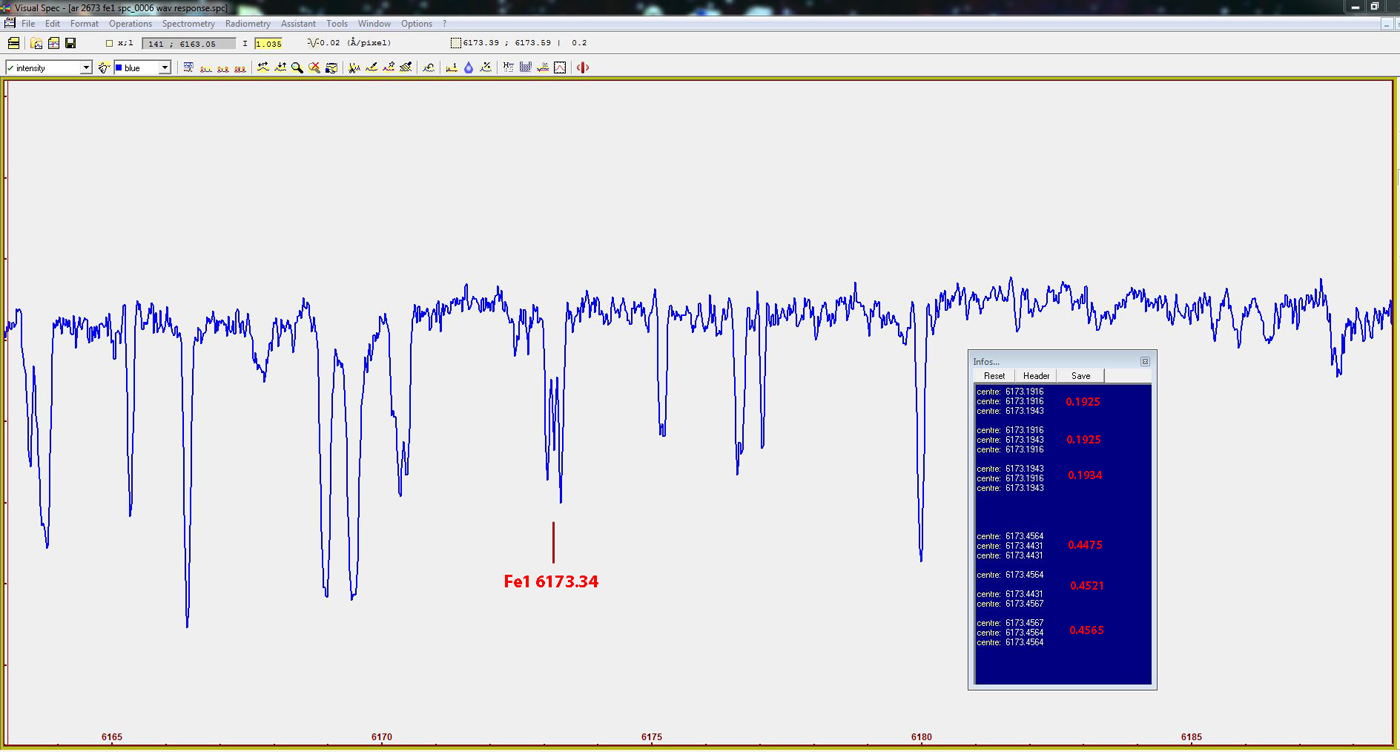
Le differenze delle medie
delle tre misure delle due cuspidi
a lato del centro riga ed il relativo d
lambda sono state
rispettivamente pari a:
The difference of the median of the three measures and related d lambda were:
E la loro media pari a
And their
median of
0.2592 A ; d /lambda 0.1296 A
Quindi, applicando la
formula precedente:
Then,
applying the previous formula:
0.1296 x 10 ^13
= 2913 Gauss
444886721
E l’errore:
And the
error:
0.1315-0.1275/2= 0.002 A,
ovvero:
0.002 x 10 ^13
=
45 Gauss
Quindi
B= 2913
+- 45 Gauss
AR 2683 - 30 settembre 2017
Un'altra macchia di medie dimensioni,monopolare divisa da un light bridge, che ha contraddistinto insieme alle altre una seconda metà dell'anno con un inaspettato livello di attività rispetto al semestre precedente.
Another sunspot of medium extension, with a light bridge, which,with the others, has featured in the second half of the year an unexpected increase of activity respect to the previous half year.
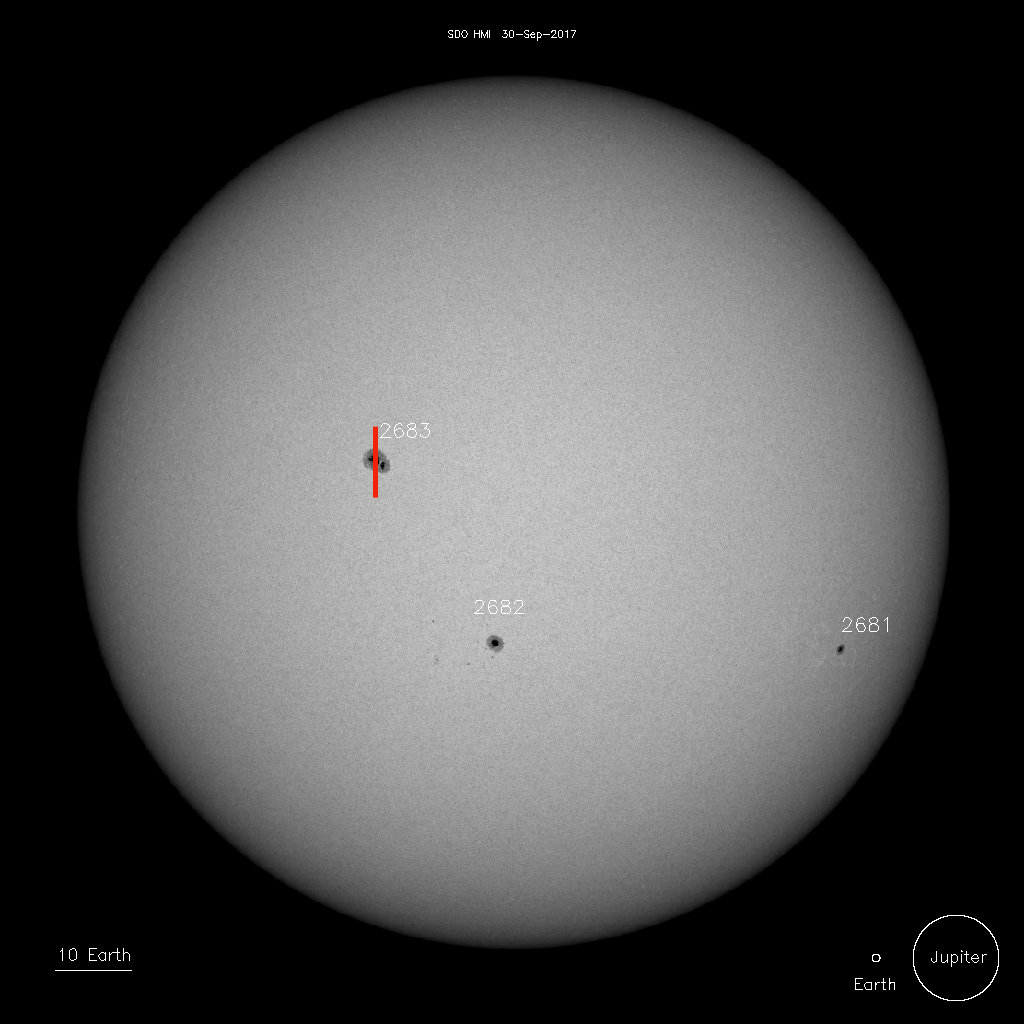
Stavolta ho dovuto effettuare uno stretching lineare sull'immagine dello spettro bidimensionale per schiarire l'ombra ed evidenziare lo splitting della riga nell'ombra.
This time I had to perform a linear stretching on the two dimensional spectrum to make evident the splitting of the line in the umbra
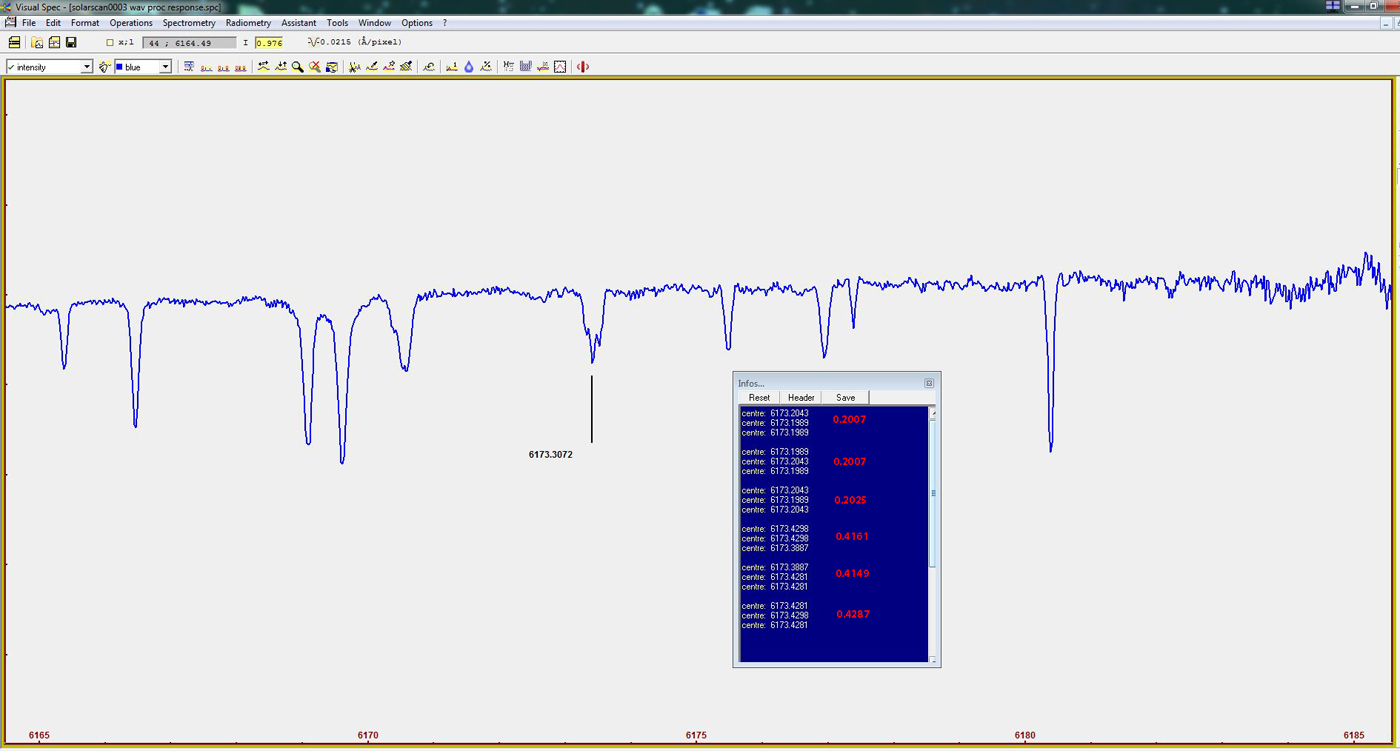
Le differenze delle medie
delle tre misure delle due cuspidi
a lato del centro riga ed il relativo d
lambda sono state
rispettivamente pari a:
The difference of the median of the three measures and related d lambda were:
E la loro media pari a
And their
median of
0.2186 A ; d /lambda 0.1093 A
Quindi, applicando la
formula precedente:
Then,
applying the previous formula:
0.1093 x 10 ^13
= 2457 Gauss
444886721
E l’errore:
And the
error:
0.1131-0.1071/2= 0.003 A,
ovvero:
0.003 x 10 ^13
=
67 Gauss
Quindi
B=
2457+- 67 Gauss